Starbucks Marketing Strategy Analysis
VerifiedAdded on 2020/05/28
|23
|4661
|69
AI Summary
The assignment delves into the successful marketing strategies employed by Starbucks. It examines their emphasis on building strong customer relationships, managing product lifecycles, and navigating a highly competitive market. The analysis highlights key factors contributing to Starbucks' global success, including exceptional customer service, high-quality coffee, and strategic store expansion.
Contribute Materials
Your contribution can guide someone’s learning journey. Share your
documents today.
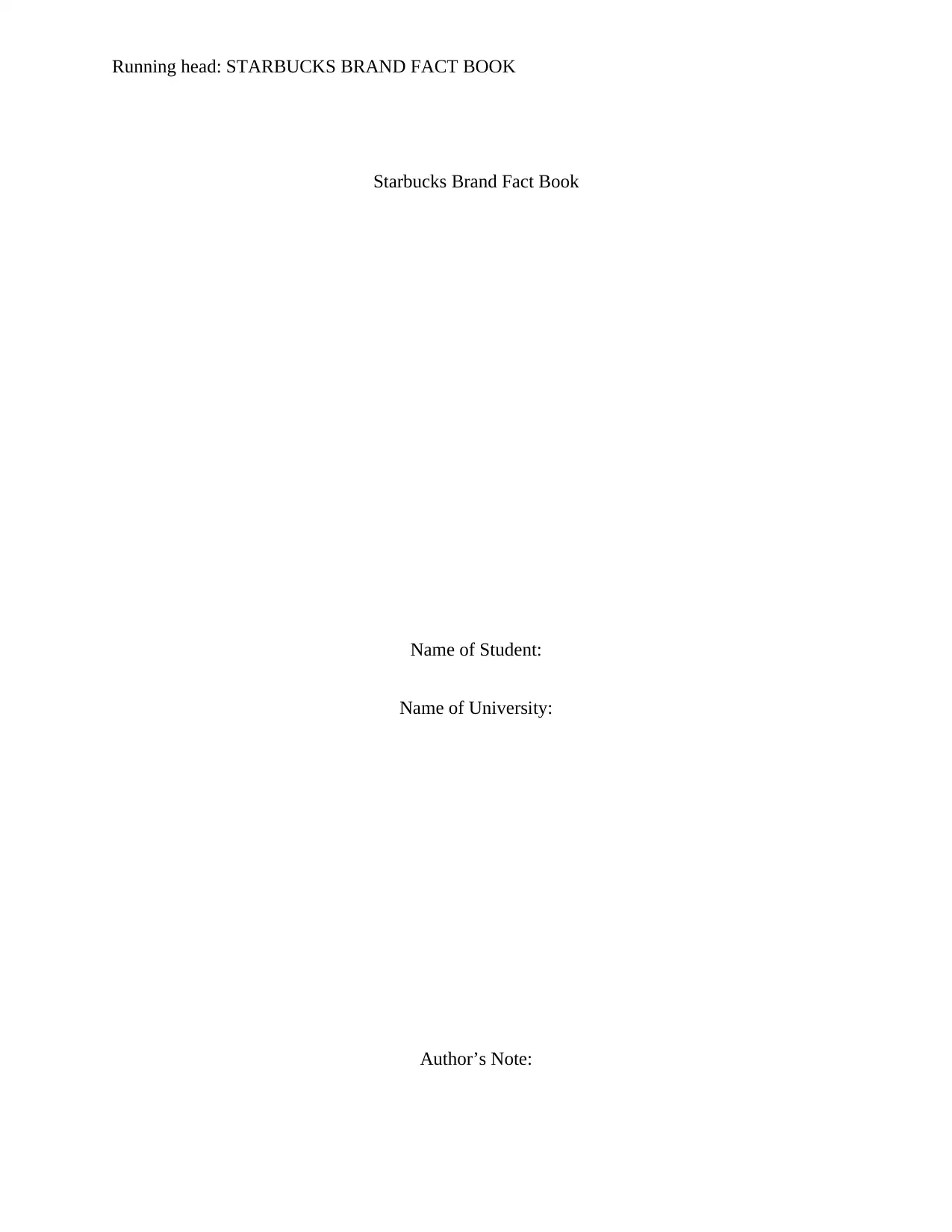
Running head: STARBUCKS BRAND FACT BOOK
Starbucks Brand Fact Book
Name of Student:
Name of University:
Author’s Note:
Starbucks Brand Fact Book
Name of Student:
Name of University:
Author’s Note:
Secure Best Marks with AI Grader
Need help grading? Try our AI Grader for instant feedback on your assignments.
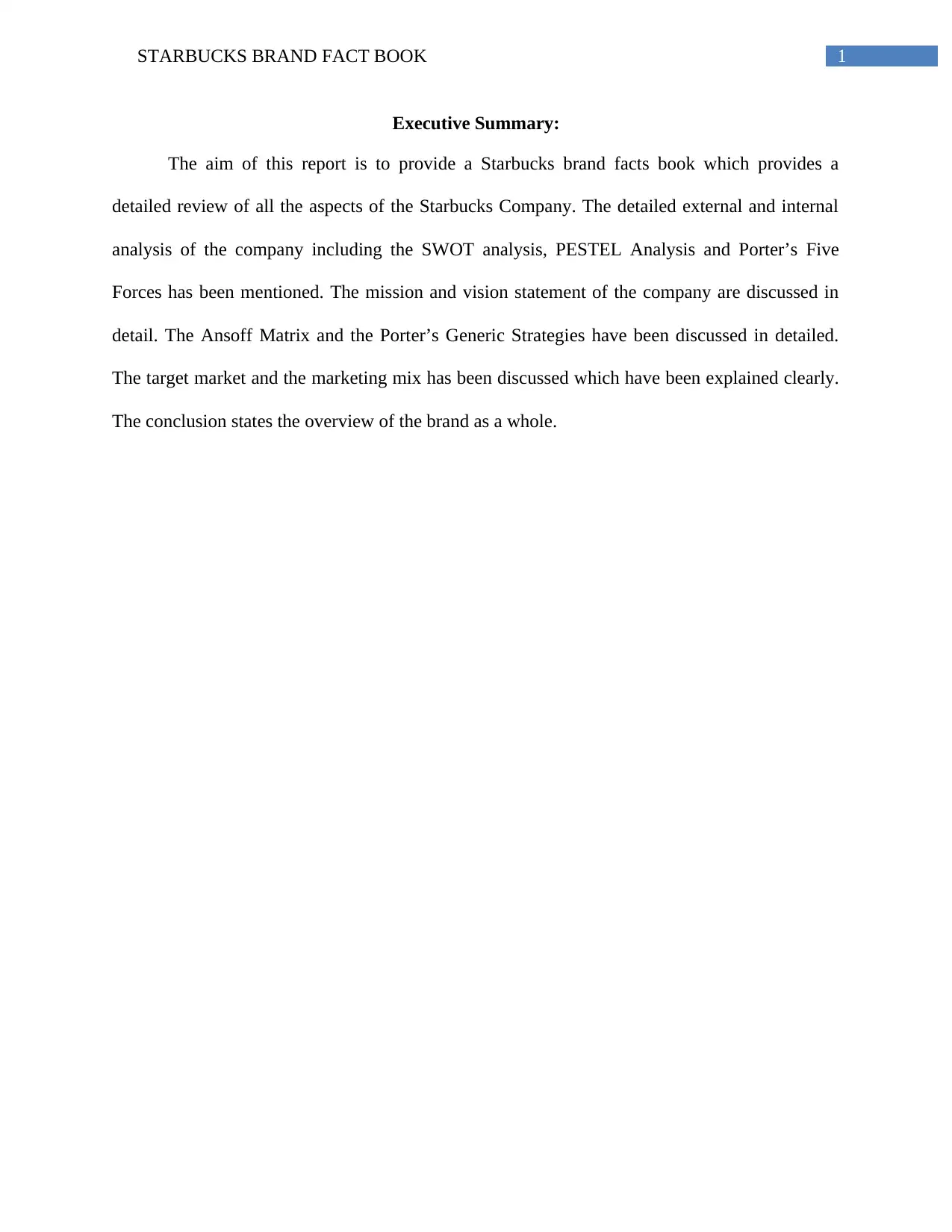
1STARBUCKS BRAND FACT BOOK
Executive Summary:
The aim of this report is to provide a Starbucks brand facts book which provides a
detailed review of all the aspects of the Starbucks Company. The detailed external and internal
analysis of the company including the SWOT analysis, PESTEL Analysis and Porter’s Five
Forces has been mentioned. The mission and vision statement of the company are discussed in
detail. The Ansoff Matrix and the Porter’s Generic Strategies have been discussed in detailed.
The target market and the marketing mix has been discussed which have been explained clearly.
The conclusion states the overview of the brand as a whole.
Executive Summary:
The aim of this report is to provide a Starbucks brand facts book which provides a
detailed review of all the aspects of the Starbucks Company. The detailed external and internal
analysis of the company including the SWOT analysis, PESTEL Analysis and Porter’s Five
Forces has been mentioned. The mission and vision statement of the company are discussed in
detail. The Ansoff Matrix and the Porter’s Generic Strategies have been discussed in detailed.
The target market and the marketing mix has been discussed which have been explained clearly.
The conclusion states the overview of the brand as a whole.
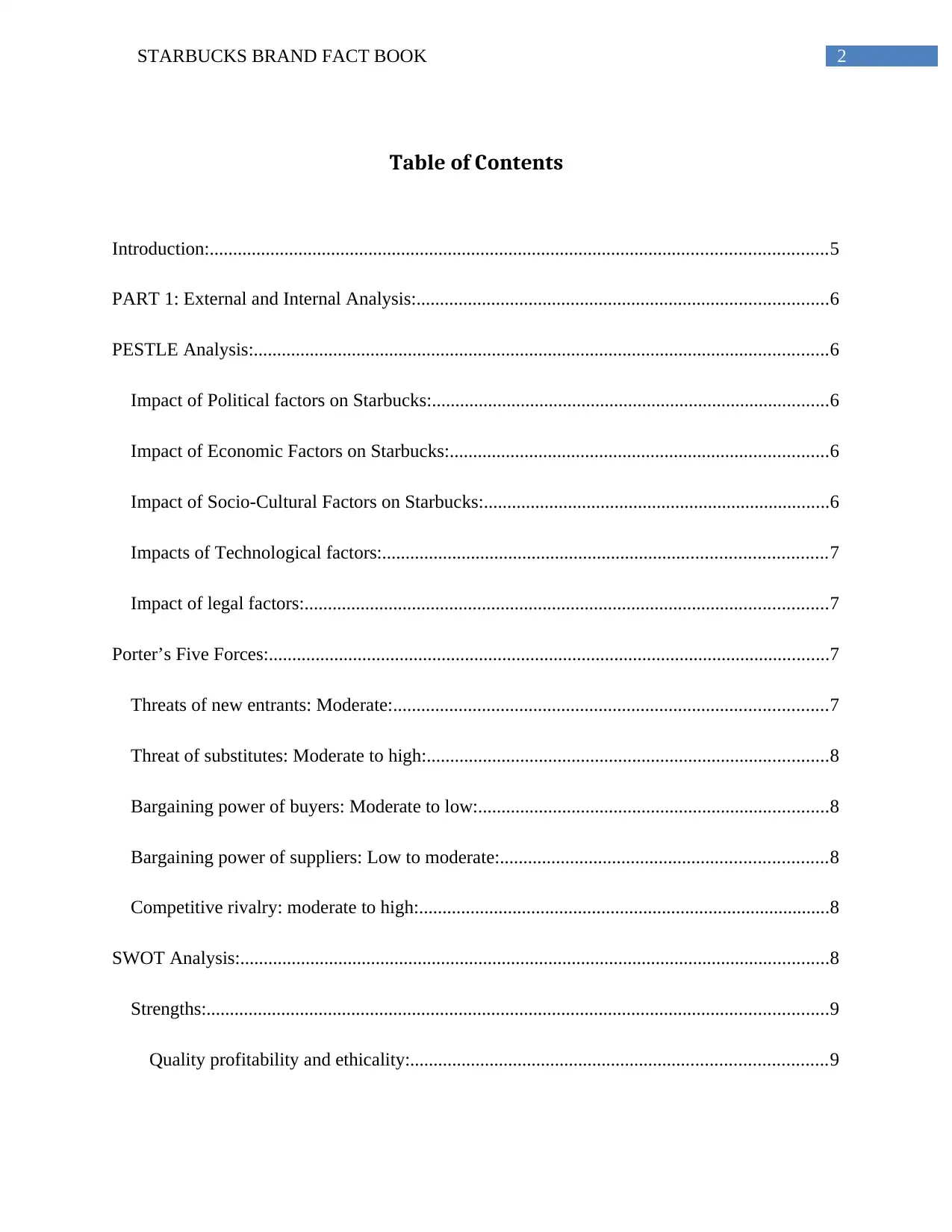
2STARBUCKS BRAND FACT BOOK
Table of Contents
Introduction:....................................................................................................................................5
PART 1: External and Internal Analysis:........................................................................................6
PESTLE Analysis:...........................................................................................................................6
Impact of Political factors on Starbucks:.....................................................................................6
Impact of Economic Factors on Starbucks:.................................................................................6
Impact of Socio-Cultural Factors on Starbucks:..........................................................................6
Impacts of Technological factors:...............................................................................................7
Impact of legal factors:................................................................................................................7
Porter’s Five Forces:........................................................................................................................7
Threats of new entrants: Moderate:.............................................................................................7
Threat of substitutes: Moderate to high:......................................................................................8
Bargaining power of buyers: Moderate to low:...........................................................................8
Bargaining power of suppliers: Low to moderate:......................................................................8
Competitive rivalry: moderate to high:........................................................................................8
SWOT Analysis:..............................................................................................................................8
Strengths:.....................................................................................................................................9
Quality profitability and ethicality:.........................................................................................9
Table of Contents
Introduction:....................................................................................................................................5
PART 1: External and Internal Analysis:........................................................................................6
PESTLE Analysis:...........................................................................................................................6
Impact of Political factors on Starbucks:.....................................................................................6
Impact of Economic Factors on Starbucks:.................................................................................6
Impact of Socio-Cultural Factors on Starbucks:..........................................................................6
Impacts of Technological factors:...............................................................................................7
Impact of legal factors:................................................................................................................7
Porter’s Five Forces:........................................................................................................................7
Threats of new entrants: Moderate:.............................................................................................7
Threat of substitutes: Moderate to high:......................................................................................8
Bargaining power of buyers: Moderate to low:...........................................................................8
Bargaining power of suppliers: Low to moderate:......................................................................8
Competitive rivalry: moderate to high:........................................................................................8
SWOT Analysis:..............................................................................................................................8
Strengths:.....................................................................................................................................9
Quality profitability and ethicality:.........................................................................................9

3STARBUCKS BRAND FACT BOOK
Efficiency and strategy for reinvestment:................................................................................9
Employee treatment:................................................................................................................9
Weaknesses:...............................................................................................................................10
High Price point:....................................................................................................................10
Lack of products that are too unique:....................................................................................10
Opportunities:............................................................................................................................10
Global expansion:..................................................................................................................10
Introducing new products and co-branding:..........................................................................11
Threats:......................................................................................................................................11
Fierce competition from other cheap alternatives:................................................................11
A specific market:..................................................................................................................11
PART 2: Strategy:..........................................................................................................................12
Mission and Vision:...................................................................................................................12
Starbucks’ Vision Statement:................................................................................................12
Starbucks’ Vision Statement:................................................................................................12
Ansoff Matrix:...........................................................................................................................13
Existing product and existing market (Market penetration):.................................................13
Existing market and new product (Product Development):..................................................13
New Market and existing product (Market Development):...................................................13
New Market and New Product (Diversification):..................................................................13
Efficiency and strategy for reinvestment:................................................................................9
Employee treatment:................................................................................................................9
Weaknesses:...............................................................................................................................10
High Price point:....................................................................................................................10
Lack of products that are too unique:....................................................................................10
Opportunities:............................................................................................................................10
Global expansion:..................................................................................................................10
Introducing new products and co-branding:..........................................................................11
Threats:......................................................................................................................................11
Fierce competition from other cheap alternatives:................................................................11
A specific market:..................................................................................................................11
PART 2: Strategy:..........................................................................................................................12
Mission and Vision:...................................................................................................................12
Starbucks’ Vision Statement:................................................................................................12
Starbucks’ Vision Statement:................................................................................................12
Ansoff Matrix:...........................................................................................................................13
Existing product and existing market (Market penetration):.................................................13
Existing market and new product (Product Development):..................................................13
New Market and existing product (Market Development):...................................................13
New Market and New Product (Diversification):..................................................................13
Secure Best Marks with AI Grader
Need help grading? Try our AI Grader for instant feedback on your assignments.
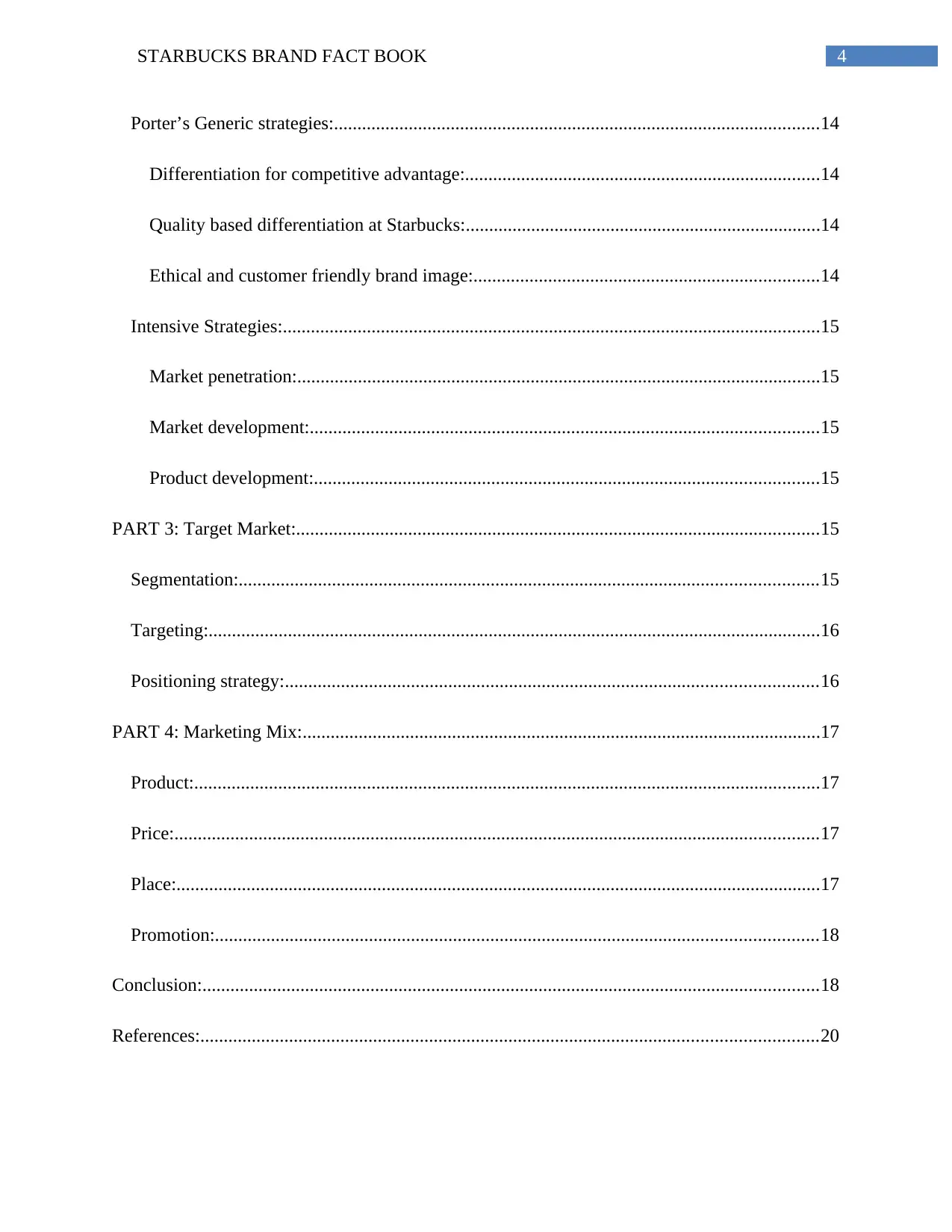
4STARBUCKS BRAND FACT BOOK
Porter’s Generic strategies:........................................................................................................14
Differentiation for competitive advantage:............................................................................14
Quality based differentiation at Starbucks:............................................................................14
Ethical and customer friendly brand image:..........................................................................14
Intensive Strategies:...................................................................................................................15
Market penetration:................................................................................................................15
Market development:.............................................................................................................15
Product development:............................................................................................................15
PART 3: Target Market:................................................................................................................15
Segmentation:............................................................................................................................15
Targeting:...................................................................................................................................16
Positioning strategy:..................................................................................................................16
PART 4: Marketing Mix:...............................................................................................................17
Product:......................................................................................................................................17
Price:..........................................................................................................................................17
Place:..........................................................................................................................................17
Promotion:.................................................................................................................................18
Conclusion:....................................................................................................................................18
References:....................................................................................................................................20
Porter’s Generic strategies:........................................................................................................14
Differentiation for competitive advantage:............................................................................14
Quality based differentiation at Starbucks:............................................................................14
Ethical and customer friendly brand image:..........................................................................14
Intensive Strategies:...................................................................................................................15
Market penetration:................................................................................................................15
Market development:.............................................................................................................15
Product development:............................................................................................................15
PART 3: Target Market:................................................................................................................15
Segmentation:............................................................................................................................15
Targeting:...................................................................................................................................16
Positioning strategy:..................................................................................................................16
PART 4: Marketing Mix:...............................................................................................................17
Product:......................................................................................................................................17
Price:..........................................................................................................................................17
Place:..........................................................................................................................................17
Promotion:.................................................................................................................................18
Conclusion:....................................................................................................................................18
References:....................................................................................................................................20
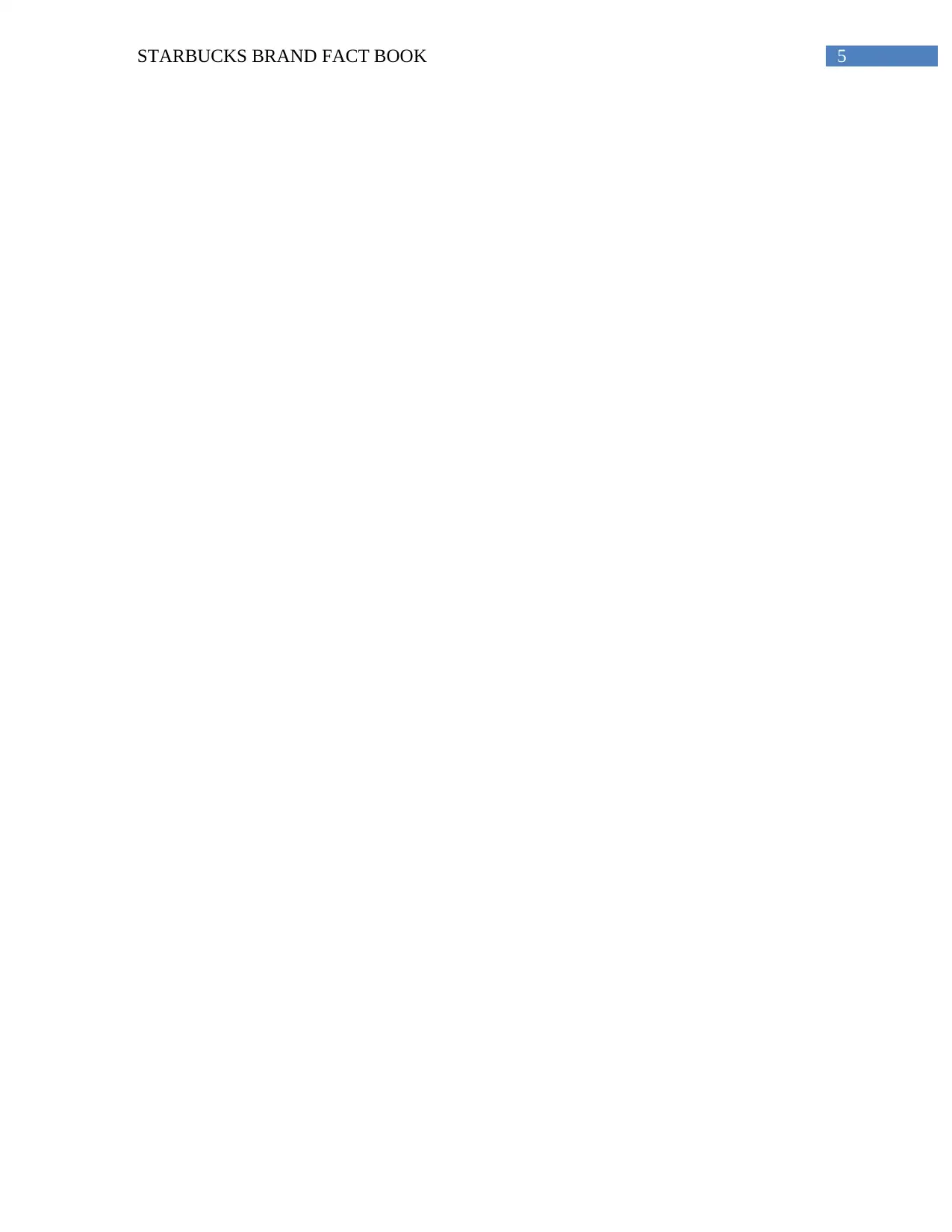
5STARBUCKS BRAND FACT BOOK
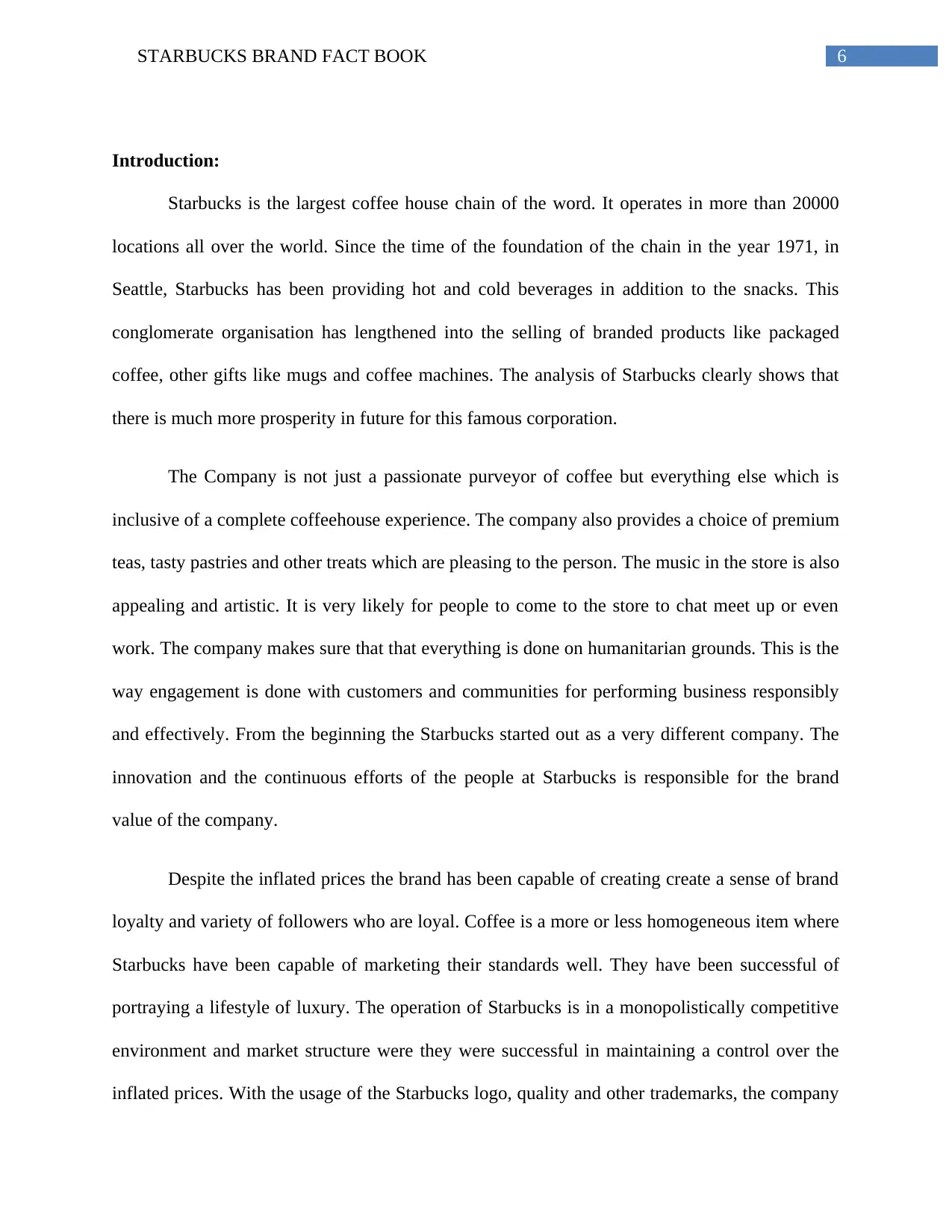
6STARBUCKS BRAND FACT BOOK
Introduction:
Starbucks is the largest coffee house chain of the word. It operates in more than 20000
locations all over the world. Since the time of the foundation of the chain in the year 1971, in
Seattle, Starbucks has been providing hot and cold beverages in addition to the snacks. This
conglomerate organisation has lengthened into the selling of branded products like packaged
coffee, other gifts like mugs and coffee machines. The analysis of Starbucks clearly shows that
there is much more prosperity in future for this famous corporation.
The Company is not just a passionate purveyor of coffee but everything else which is
inclusive of a complete coffeehouse experience. The company also provides a choice of premium
teas, tasty pastries and other treats which are pleasing to the person. The music in the store is also
appealing and artistic. It is very likely for people to come to the store to chat meet up or even
work. The company makes sure that that everything is done on humanitarian grounds. This is the
way engagement is done with customers and communities for performing business responsibly
and effectively. From the beginning the Starbucks started out as a very different company. The
innovation and the continuous efforts of the people at Starbucks is responsible for the brand
value of the company.
Despite the inflated prices the brand has been capable of creating create a sense of brand
loyalty and variety of followers who are loyal. Coffee is a more or less homogeneous item where
Starbucks have been capable of marketing their standards well. They have been successful of
portraying a lifestyle of luxury. The operation of Starbucks is in a monopolistically competitive
environment and market structure were they were successful in maintaining a control over the
inflated prices. With the usage of the Starbucks logo, quality and other trademarks, the company
Introduction:
Starbucks is the largest coffee house chain of the word. It operates in more than 20000
locations all over the world. Since the time of the foundation of the chain in the year 1971, in
Seattle, Starbucks has been providing hot and cold beverages in addition to the snacks. This
conglomerate organisation has lengthened into the selling of branded products like packaged
coffee, other gifts like mugs and coffee machines. The analysis of Starbucks clearly shows that
there is much more prosperity in future for this famous corporation.
The Company is not just a passionate purveyor of coffee but everything else which is
inclusive of a complete coffeehouse experience. The company also provides a choice of premium
teas, tasty pastries and other treats which are pleasing to the person. The music in the store is also
appealing and artistic. It is very likely for people to come to the store to chat meet up or even
work. The company makes sure that that everything is done on humanitarian grounds. This is the
way engagement is done with customers and communities for performing business responsibly
and effectively. From the beginning the Starbucks started out as a very different company. The
innovation and the continuous efforts of the people at Starbucks is responsible for the brand
value of the company.
Despite the inflated prices the brand has been capable of creating create a sense of brand
loyalty and variety of followers who are loyal. Coffee is a more or less homogeneous item where
Starbucks have been capable of marketing their standards well. They have been successful of
portraying a lifestyle of luxury. The operation of Starbucks is in a monopolistically competitive
environment and market structure were they were successful in maintaining a control over the
inflated prices. With the usage of the Starbucks logo, quality and other trademarks, the company
Paraphrase This Document
Need a fresh take? Get an instant paraphrase of this document with our AI Paraphraser
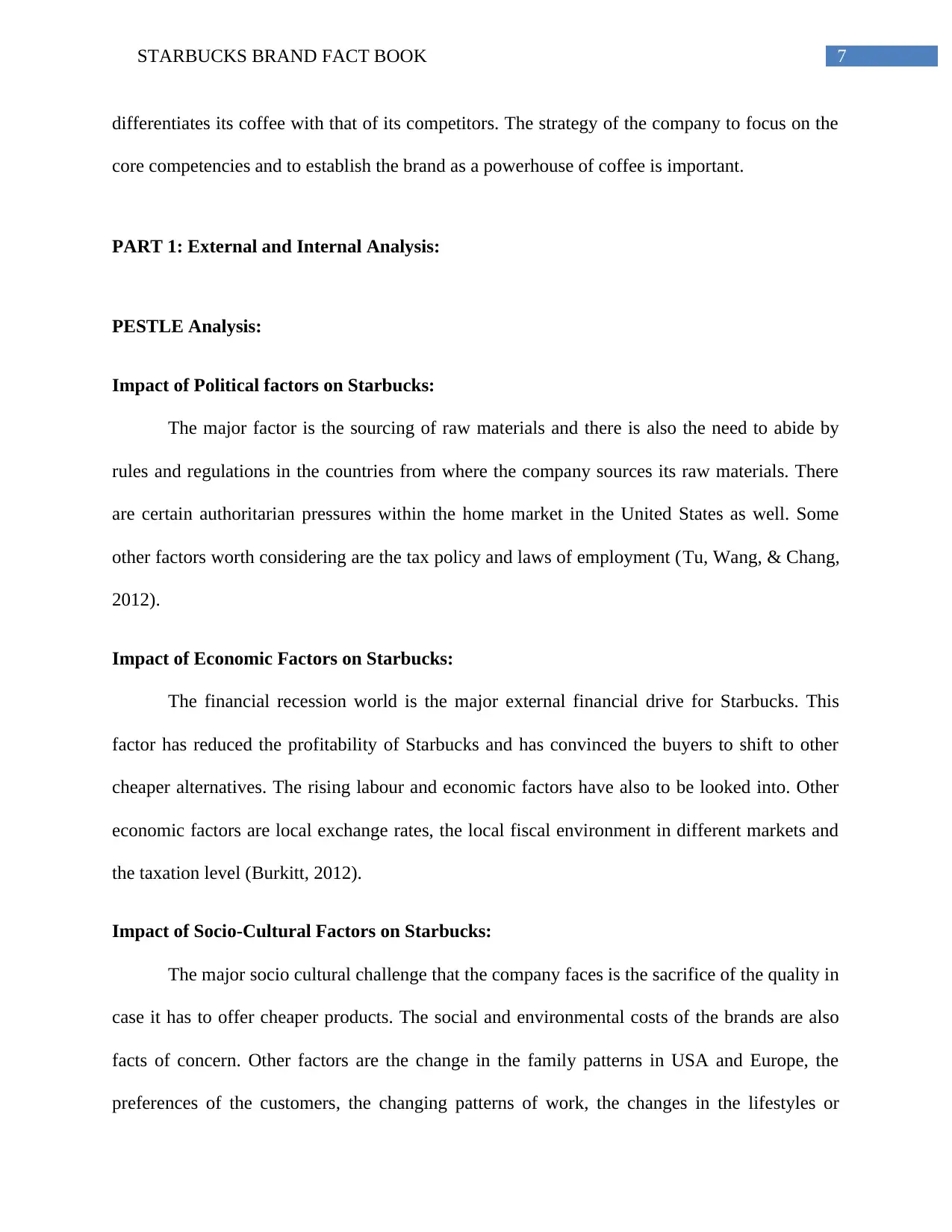
7STARBUCKS BRAND FACT BOOK
differentiates its coffee with that of its competitors. The strategy of the company to focus on the
core competencies and to establish the brand as a powerhouse of coffee is important.
PART 1: External and Internal Analysis:
PESTLE Analysis:
Impact of Political factors on Starbucks:
The major factor is the sourcing of raw materials and there is also the need to abide by
rules and regulations in the countries from where the company sources its raw materials. There
are certain authoritarian pressures within the home market in the United States as well. Some
other factors worth considering are the tax policy and laws of employment (Tu, Wang, & Chang,
2012).
Impact of Economic Factors on Starbucks:
The financial recession world is the major external financial drive for Starbucks. This
factor has reduced the profitability of Starbucks and has convinced the buyers to shift to other
cheaper alternatives. The rising labour and economic factors have also to be looked into. Other
economic factors are local exchange rates, the local fiscal environment in different markets and
the taxation level (Burkitt, 2012).
Impact of Socio-Cultural Factors on Starbucks:
The major socio cultural challenge that the company faces is the sacrifice of the quality in
case it has to offer cheaper products. The social and environmental costs of the brands are also
facts of concern. Other factors are the change in the family patterns in USA and Europe, the
preferences of the customers, the changing patterns of work, the changes in the lifestyles or
differentiates its coffee with that of its competitors. The strategy of the company to focus on the
core competencies and to establish the brand as a powerhouse of coffee is important.
PART 1: External and Internal Analysis:
PESTLE Analysis:
Impact of Political factors on Starbucks:
The major factor is the sourcing of raw materials and there is also the need to abide by
rules and regulations in the countries from where the company sources its raw materials. There
are certain authoritarian pressures within the home market in the United States as well. Some
other factors worth considering are the tax policy and laws of employment (Tu, Wang, & Chang,
2012).
Impact of Economic Factors on Starbucks:
The financial recession world is the major external financial drive for Starbucks. This
factor has reduced the profitability of Starbucks and has convinced the buyers to shift to other
cheaper alternatives. The rising labour and economic factors have also to be looked into. Other
economic factors are local exchange rates, the local fiscal environment in different markets and
the taxation level (Burkitt, 2012).
Impact of Socio-Cultural Factors on Starbucks:
The major socio cultural challenge that the company faces is the sacrifice of the quality in
case it has to offer cheaper products. The social and environmental costs of the brands are also
facts of concern. Other factors are the change in the family patterns in USA and Europe, the
preferences of the customers, the changing patterns of work, the changes in the lifestyles or
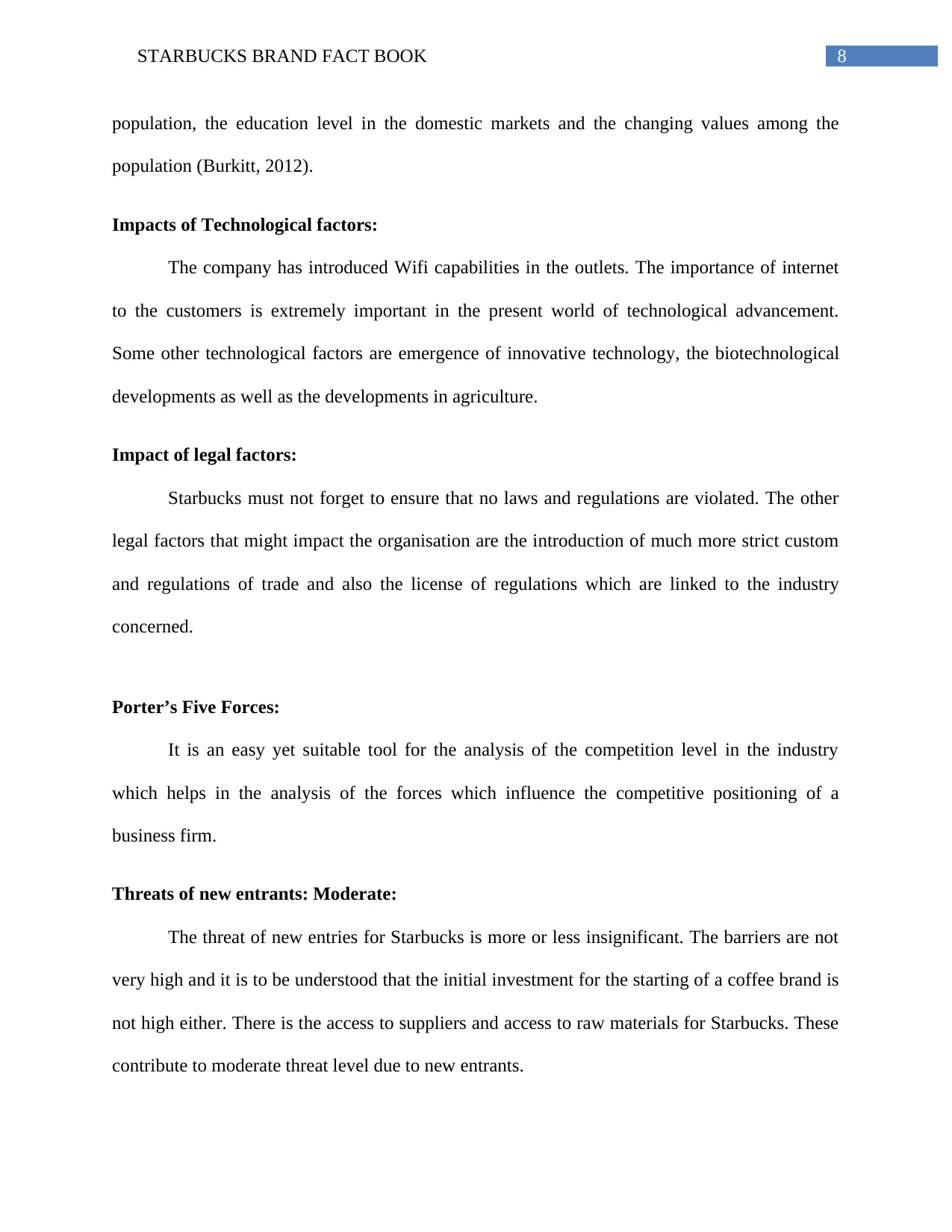
8STARBUCKS BRAND FACT BOOK
population, the education level in the domestic markets and the changing values among the
population (Burkitt, 2012).
Impacts of Technological factors:
The company has introduced Wifi capabilities in the outlets. The importance of internet
to the customers is extremely important in the present world of technological advancement.
Some other technological factors are emergence of innovative technology, the biotechnological
developments as well as the developments in agriculture.
Impact of legal factors:
Starbucks must not forget to ensure that no laws and regulations are violated. The other
legal factors that might impact the organisation are the introduction of much more strict custom
and regulations of trade and also the license of regulations which are linked to the industry
concerned.
Porter’s Five Forces:
It is an easy yet suitable tool for the analysis of the competition level in the industry
which helps in the analysis of the forces which influence the competitive positioning of a
business firm.
Threats of new entrants: Moderate:
The threat of new entries for Starbucks is more or less insignificant. The barriers are not
very high and it is to be understood that the initial investment for the starting of a coffee brand is
not high either. There is the access to suppliers and access to raw materials for Starbucks. These
contribute to moderate threat level due to new entrants.
population, the education level in the domestic markets and the changing values among the
population (Burkitt, 2012).
Impacts of Technological factors:
The company has introduced Wifi capabilities in the outlets. The importance of internet
to the customers is extremely important in the present world of technological advancement.
Some other technological factors are emergence of innovative technology, the biotechnological
developments as well as the developments in agriculture.
Impact of legal factors:
Starbucks must not forget to ensure that no laws and regulations are violated. The other
legal factors that might impact the organisation are the introduction of much more strict custom
and regulations of trade and also the license of regulations which are linked to the industry
concerned.
Porter’s Five Forces:
It is an easy yet suitable tool for the analysis of the competition level in the industry
which helps in the analysis of the forces which influence the competitive positioning of a
business firm.
Threats of new entrants: Moderate:
The threat of new entries for Starbucks is more or less insignificant. The barriers are not
very high and it is to be understood that the initial investment for the starting of a coffee brand is
not high either. There is the access to suppliers and access to raw materials for Starbucks. These
contribute to moderate threat level due to new entrants.
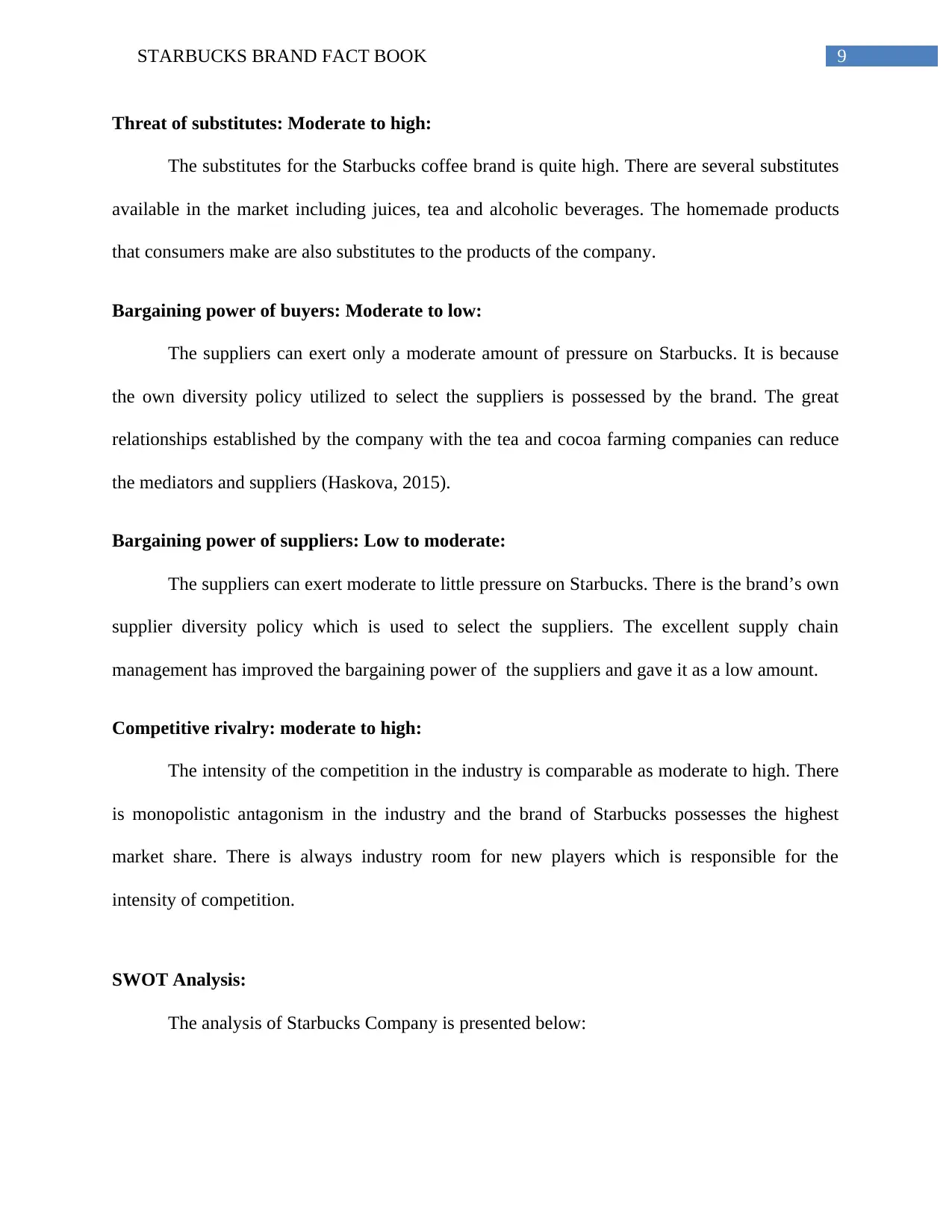
9STARBUCKS BRAND FACT BOOK
Threat of substitutes: Moderate to high:
The substitutes for the Starbucks coffee brand is quite high. There are several substitutes
available in the market including juices, tea and alcoholic beverages. The homemade products
that consumers make are also substitutes to the products of the company.
Bargaining power of buyers: Moderate to low:
The suppliers can exert only a moderate amount of pressure on Starbucks. It is because
the own diversity policy utilized to select the suppliers is possessed by the brand. The great
relationships established by the company with the tea and cocoa farming companies can reduce
the mediators and suppliers (Haskova, 2015).
Bargaining power of suppliers: Low to moderate:
The suppliers can exert moderate to little pressure on Starbucks. There is the brand’s own
supplier diversity policy which is used to select the suppliers. The excellent supply chain
management has improved the bargaining power of the suppliers and gave it as a low amount.
Competitive rivalry: moderate to high:
The intensity of the competition in the industry is comparable as moderate to high. There
is monopolistic antagonism in the industry and the brand of Starbucks possesses the highest
market share. There is always industry room for new players which is responsible for the
intensity of competition.
SWOT Analysis:
The analysis of Starbucks Company is presented below:
Threat of substitutes: Moderate to high:
The substitutes for the Starbucks coffee brand is quite high. There are several substitutes
available in the market including juices, tea and alcoholic beverages. The homemade products
that consumers make are also substitutes to the products of the company.
Bargaining power of buyers: Moderate to low:
The suppliers can exert only a moderate amount of pressure on Starbucks. It is because
the own diversity policy utilized to select the suppliers is possessed by the brand. The great
relationships established by the company with the tea and cocoa farming companies can reduce
the mediators and suppliers (Haskova, 2015).
Bargaining power of suppliers: Low to moderate:
The suppliers can exert moderate to little pressure on Starbucks. There is the brand’s own
supplier diversity policy which is used to select the suppliers. The excellent supply chain
management has improved the bargaining power of the suppliers and gave it as a low amount.
Competitive rivalry: moderate to high:
The intensity of the competition in the industry is comparable as moderate to high. There
is monopolistic antagonism in the industry and the brand of Starbucks possesses the highest
market share. There is always industry room for new players which is responsible for the
intensity of competition.
SWOT Analysis:
The analysis of Starbucks Company is presented below:
Secure Best Marks with AI Grader
Need help grading? Try our AI Grader for instant feedback on your assignments.
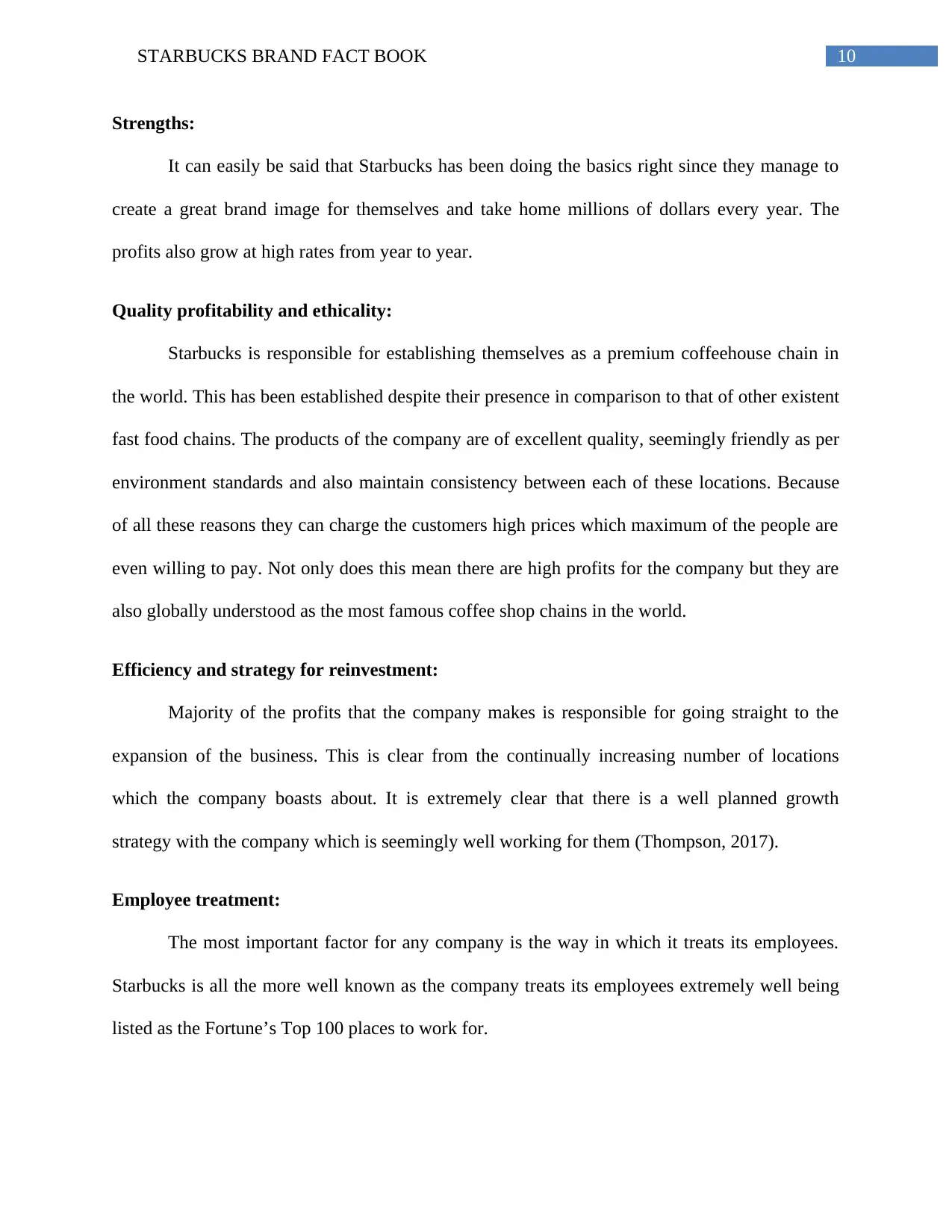
10STARBUCKS BRAND FACT BOOK
Strengths:
It can easily be said that Starbucks has been doing the basics right since they manage to
create a great brand image for themselves and take home millions of dollars every year. The
profits also grow at high rates from year to year.
Quality profitability and ethicality:
Starbucks is responsible for establishing themselves as a premium coffeehouse chain in
the world. This has been established despite their presence in comparison to that of other existent
fast food chains. The products of the company are of excellent quality, seemingly friendly as per
environment standards and also maintain consistency between each of these locations. Because
of all these reasons they can charge the customers high prices which maximum of the people are
even willing to pay. Not only does this mean there are high profits for the company but they are
also globally understood as the most famous coffee shop chains in the world.
Efficiency and strategy for reinvestment:
Majority of the profits that the company makes is responsible for going straight to the
expansion of the business. This is clear from the continually increasing number of locations
which the company boasts about. It is extremely clear that there is a well planned growth
strategy with the company which is seemingly well working for them (Thompson, 2017).
Employee treatment:
The most important factor for any company is the way in which it treats its employees.
Starbucks is all the more well known as the company treats its employees extremely well being
listed as the Fortune’s Top 100 places to work for.
Strengths:
It can easily be said that Starbucks has been doing the basics right since they manage to
create a great brand image for themselves and take home millions of dollars every year. The
profits also grow at high rates from year to year.
Quality profitability and ethicality:
Starbucks is responsible for establishing themselves as a premium coffeehouse chain in
the world. This has been established despite their presence in comparison to that of other existent
fast food chains. The products of the company are of excellent quality, seemingly friendly as per
environment standards and also maintain consistency between each of these locations. Because
of all these reasons they can charge the customers high prices which maximum of the people are
even willing to pay. Not only does this mean there are high profits for the company but they are
also globally understood as the most famous coffee shop chains in the world.
Efficiency and strategy for reinvestment:
Majority of the profits that the company makes is responsible for going straight to the
expansion of the business. This is clear from the continually increasing number of locations
which the company boasts about. It is extremely clear that there is a well planned growth
strategy with the company which is seemingly well working for them (Thompson, 2017).
Employee treatment:
The most important factor for any company is the way in which it treats its employees.
Starbucks is all the more well known as the company treats its employees extremely well being
listed as the Fortune’s Top 100 places to work for.

11STARBUCKS BRAND FACT BOOK
Weaknesses:
It is natural for every company to have some weaknesses. Just like other top companies
of the world, Starbucks also has certain weaknesses. The weaknesses are discussed as follows:
High Price point:
The high price point of the company is more of a weakness than a strength. The huge
price tags on certain products are responsible for deterring several customers which might
otherwise make the Starbucks Company a part of day to day activities. Though the high quality
and proper ethical values of the company might be striking some people just do not have that
much of money for spending on a cup of coffee (Taecharungroj, 2017).
Lack of products that are too unique:
The frappucinos, pumpkin spice lattes and big chocolate chip cookies that the company is
famous for do not possess the most unique market. Several other coffee shops, chains, give
similar products but lose out only to Starbucks’ big name.
Opportunities:
The global coffee chain does have huge number of opportunities for the future which are
explained as follows. The opportunities are:
Global expansion:
Starbucks has several coffee houses around the world most of which are situated within
the United States. There are several regions which keep profitably branching out as a chance
considering India, central Europe and certain regions in Africa.
Weaknesses:
It is natural for every company to have some weaknesses. Just like other top companies
of the world, Starbucks also has certain weaknesses. The weaknesses are discussed as follows:
High Price point:
The high price point of the company is more of a weakness than a strength. The huge
price tags on certain products are responsible for deterring several customers which might
otherwise make the Starbucks Company a part of day to day activities. Though the high quality
and proper ethical values of the company might be striking some people just do not have that
much of money for spending on a cup of coffee (Taecharungroj, 2017).
Lack of products that are too unique:
The frappucinos, pumpkin spice lattes and big chocolate chip cookies that the company is
famous for do not possess the most unique market. Several other coffee shops, chains, give
similar products but lose out only to Starbucks’ big name.
Opportunities:
The global coffee chain does have huge number of opportunities for the future which are
explained as follows. The opportunities are:
Global expansion:
Starbucks has several coffee houses around the world most of which are situated within
the United States. There are several regions which keep profitably branching out as a chance
considering India, central Europe and certain regions in Africa.
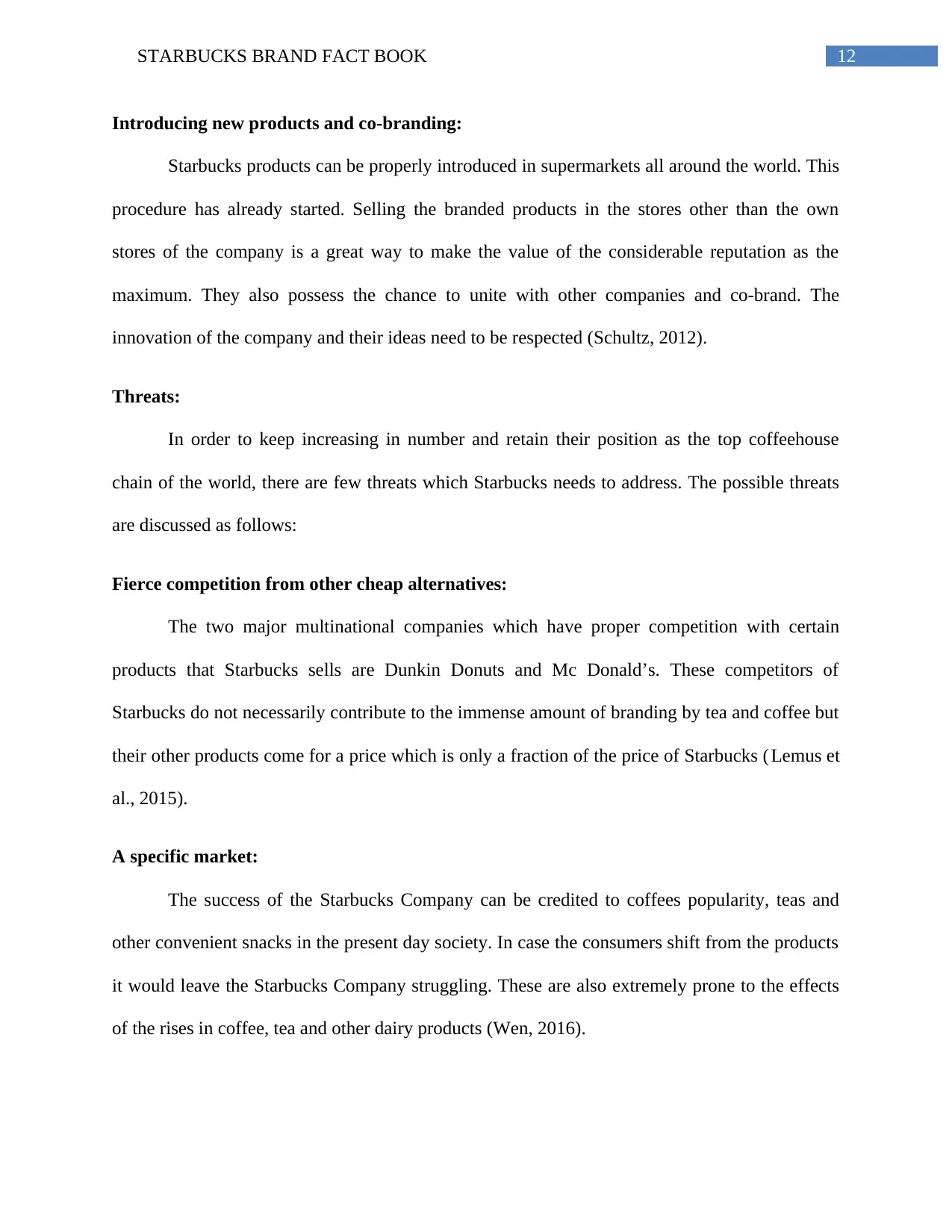
12STARBUCKS BRAND FACT BOOK
Introducing new products and co-branding:
Starbucks products can be properly introduced in supermarkets all around the world. This
procedure has already started. Selling the branded products in the stores other than the own
stores of the company is a great way to make the value of the considerable reputation as the
maximum. They also possess the chance to unite with other companies and co-brand. The
innovation of the company and their ideas need to be respected (Schultz, 2012).
Threats:
In order to keep increasing in number and retain their position as the top coffeehouse
chain of the world, there are few threats which Starbucks needs to address. The possible threats
are discussed as follows:
Fierce competition from other cheap alternatives:
The two major multinational companies which have proper competition with certain
products that Starbucks sells are Dunkin Donuts and Mc Donald’s. These competitors of
Starbucks do not necessarily contribute to the immense amount of branding by tea and coffee but
their other products come for a price which is only a fraction of the price of Starbucks (Lemus et
al., 2015).
A specific market:
The success of the Starbucks Company can be credited to coffees popularity, teas and
other convenient snacks in the present day society. In case the consumers shift from the products
it would leave the Starbucks Company struggling. These are also extremely prone to the effects
of the rises in coffee, tea and other dairy products (Wen, 2016).
Introducing new products and co-branding:
Starbucks products can be properly introduced in supermarkets all around the world. This
procedure has already started. Selling the branded products in the stores other than the own
stores of the company is a great way to make the value of the considerable reputation as the
maximum. They also possess the chance to unite with other companies and co-brand. The
innovation of the company and their ideas need to be respected (Schultz, 2012).
Threats:
In order to keep increasing in number and retain their position as the top coffeehouse
chain of the world, there are few threats which Starbucks needs to address. The possible threats
are discussed as follows:
Fierce competition from other cheap alternatives:
The two major multinational companies which have proper competition with certain
products that Starbucks sells are Dunkin Donuts and Mc Donald’s. These competitors of
Starbucks do not necessarily contribute to the immense amount of branding by tea and coffee but
their other products come for a price which is only a fraction of the price of Starbucks (Lemus et
al., 2015).
A specific market:
The success of the Starbucks Company can be credited to coffees popularity, teas and
other convenient snacks in the present day society. In case the consumers shift from the products
it would leave the Starbucks Company struggling. These are also extremely prone to the effects
of the rises in coffee, tea and other dairy products (Wen, 2016).
Paraphrase This Document
Need a fresh take? Get an instant paraphrase of this document with our AI Paraphraser
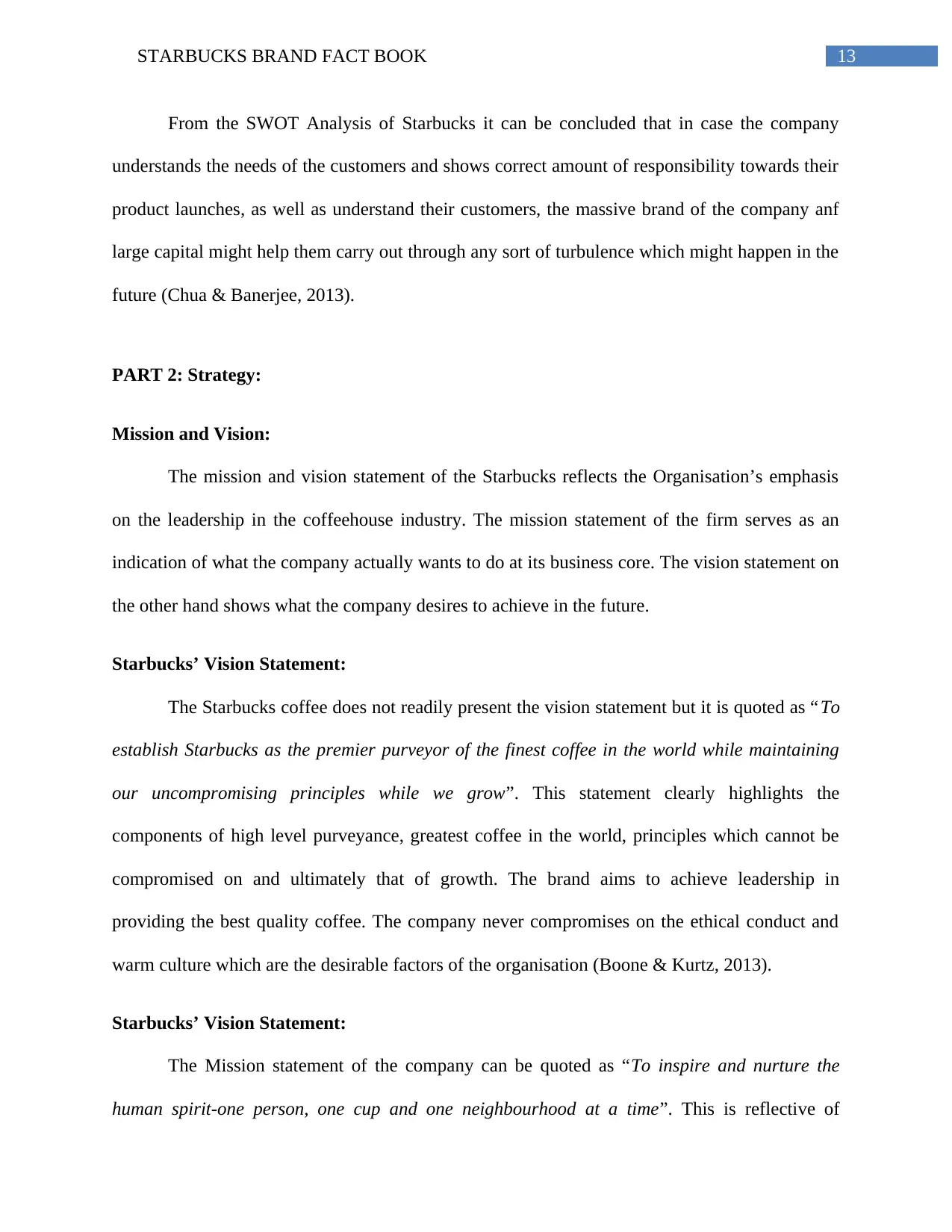
13STARBUCKS BRAND FACT BOOK
From the SWOT Analysis of Starbucks it can be concluded that in case the company
understands the needs of the customers and shows correct amount of responsibility towards their
product launches, as well as understand their customers, the massive brand of the company anf
large capital might help them carry out through any sort of turbulence which might happen in the
future (Chua & Banerjee, 2013).
PART 2: Strategy:
Mission and Vision:
The mission and vision statement of the Starbucks reflects the Organisation’s emphasis
on the leadership in the coffeehouse industry. The mission statement of the firm serves as an
indication of what the company actually wants to do at its business core. The vision statement on
the other hand shows what the company desires to achieve in the future.
Starbucks’ Vision Statement:
The Starbucks coffee does not readily present the vision statement but it is quoted as “To
establish Starbucks as the premier purveyor of the finest coffee in the world while maintaining
our uncompromising principles while we grow”. This statement clearly highlights the
components of high level purveyance, greatest coffee in the world, principles which cannot be
compromised on and ultimately that of growth. The brand aims to achieve leadership in
providing the best quality coffee. The company never compromises on the ethical conduct and
warm culture which are the desirable factors of the organisation (Boone & Kurtz, 2013).
Starbucks’ Vision Statement:
The Mission statement of the company can be quoted as “To inspire and nurture the
human spirit-one person, one cup and one neighbourhood at a time”. This is reflective of
From the SWOT Analysis of Starbucks it can be concluded that in case the company
understands the needs of the customers and shows correct amount of responsibility towards their
product launches, as well as understand their customers, the massive brand of the company anf
large capital might help them carry out through any sort of turbulence which might happen in the
future (Chua & Banerjee, 2013).
PART 2: Strategy:
Mission and Vision:
The mission and vision statement of the Starbucks reflects the Organisation’s emphasis
on the leadership in the coffeehouse industry. The mission statement of the firm serves as an
indication of what the company actually wants to do at its business core. The vision statement on
the other hand shows what the company desires to achieve in the future.
Starbucks’ Vision Statement:
The Starbucks coffee does not readily present the vision statement but it is quoted as “To
establish Starbucks as the premier purveyor of the finest coffee in the world while maintaining
our uncompromising principles while we grow”. This statement clearly highlights the
components of high level purveyance, greatest coffee in the world, principles which cannot be
compromised on and ultimately that of growth. The brand aims to achieve leadership in
providing the best quality coffee. The company never compromises on the ethical conduct and
warm culture which are the desirable factors of the organisation (Boone & Kurtz, 2013).
Starbucks’ Vision Statement:
The Mission statement of the company can be quoted as “To inspire and nurture the
human spirit-one person, one cup and one neighbourhood at a time”. This is reflective of
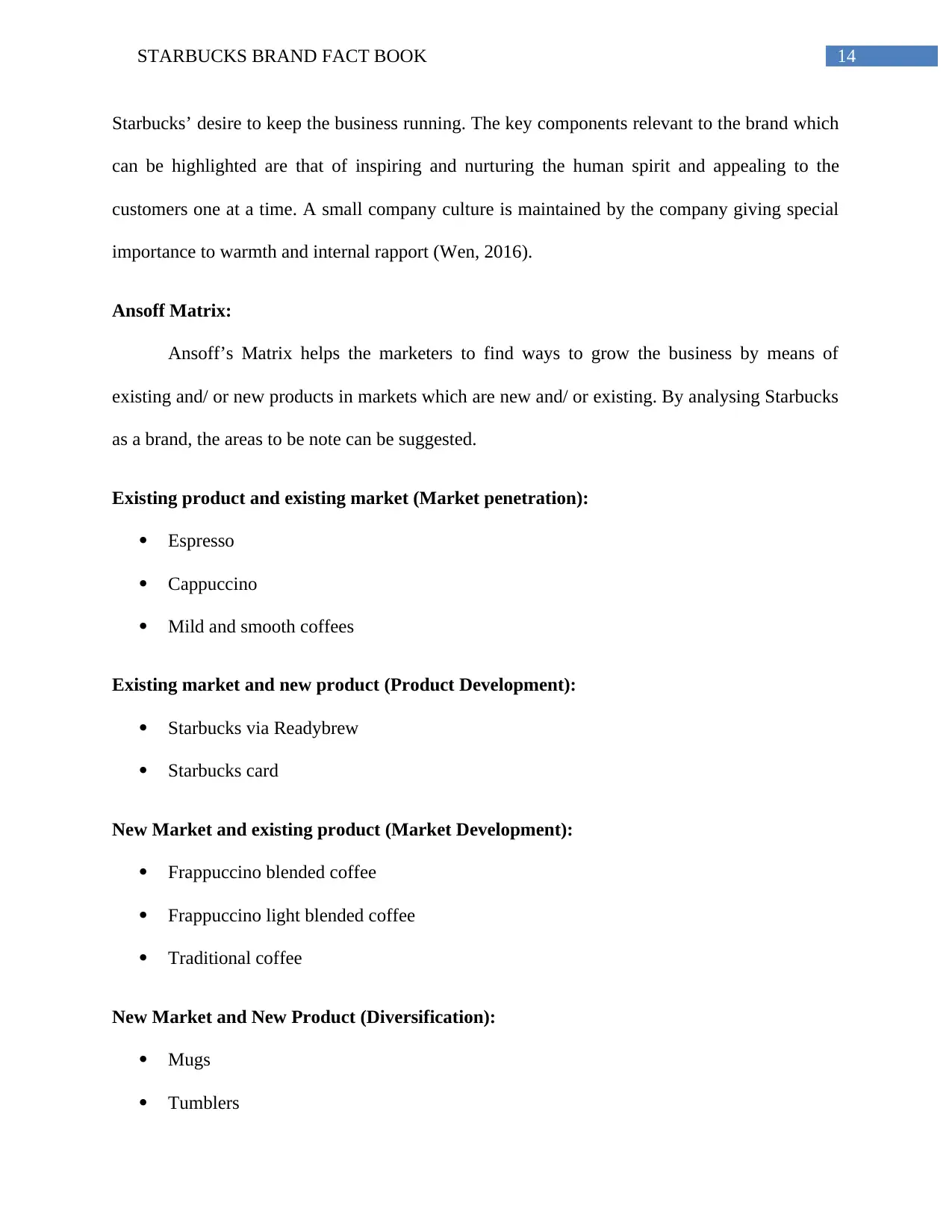
14STARBUCKS BRAND FACT BOOK
Starbucks’ desire to keep the business running. The key components relevant to the brand which
can be highlighted are that of inspiring and nurturing the human spirit and appealing to the
customers one at a time. A small company culture is maintained by the company giving special
importance to warmth and internal rapport (Wen, 2016).
Ansoff Matrix:
Ansoff’s Matrix helps the marketers to find ways to grow the business by means of
existing and/ or new products in markets which are new and/ or existing. By analysing Starbucks
as a brand, the areas to be note can be suggested.
Existing product and existing market (Market penetration):
Espresso
Cappuccino
Mild and smooth coffees
Existing market and new product (Product Development):
Starbucks via Readybrew
Starbucks card
New Market and existing product (Market Development):
Frappuccino blended coffee
Frappuccino light blended coffee
Traditional coffee
New Market and New Product (Diversification):
Mugs
Tumblers
Starbucks’ desire to keep the business running. The key components relevant to the brand which
can be highlighted are that of inspiring and nurturing the human spirit and appealing to the
customers one at a time. A small company culture is maintained by the company giving special
importance to warmth and internal rapport (Wen, 2016).
Ansoff Matrix:
Ansoff’s Matrix helps the marketers to find ways to grow the business by means of
existing and/ or new products in markets which are new and/ or existing. By analysing Starbucks
as a brand, the areas to be note can be suggested.
Existing product and existing market (Market penetration):
Espresso
Cappuccino
Mild and smooth coffees
Existing market and new product (Product Development):
Starbucks via Readybrew
Starbucks card
New Market and existing product (Market Development):
Frappuccino blended coffee
Frappuccino light blended coffee
Traditional coffee
New Market and New Product (Diversification):
Mugs
Tumblers
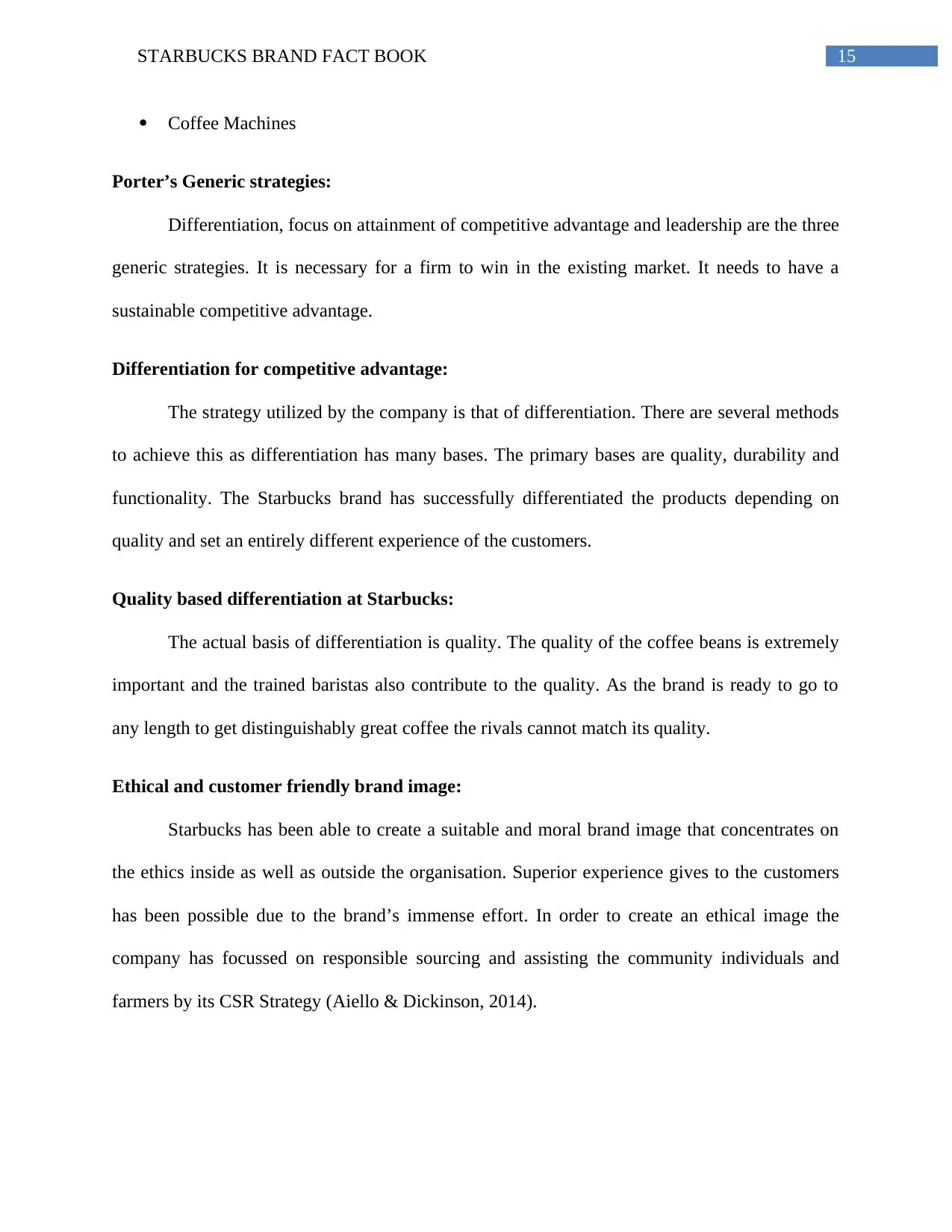
15STARBUCKS BRAND FACT BOOK
Coffee Machines
Porter’s Generic strategies:
Differentiation, focus on attainment of competitive advantage and leadership are the three
generic strategies. It is necessary for a firm to win in the existing market. It needs to have a
sustainable competitive advantage.
Differentiation for competitive advantage:
The strategy utilized by the company is that of differentiation. There are several methods
to achieve this as differentiation has many bases. The primary bases are quality, durability and
functionality. The Starbucks brand has successfully differentiated the products depending on
quality and set an entirely different experience of the customers.
Quality based differentiation at Starbucks:
The actual basis of differentiation is quality. The quality of the coffee beans is extremely
important and the trained baristas also contribute to the quality. As the brand is ready to go to
any length to get distinguishably great coffee the rivals cannot match its quality.
Ethical and customer friendly brand image:
Starbucks has been able to create a suitable and moral brand image that concentrates on
the ethics inside as well as outside the organisation. Superior experience gives to the customers
has been possible due to the brand’s immense effort. In order to create an ethical image the
company has focussed on responsible sourcing and assisting the community individuals and
farmers by its CSR Strategy (Aiello & Dickinson, 2014).
Coffee Machines
Porter’s Generic strategies:
Differentiation, focus on attainment of competitive advantage and leadership are the three
generic strategies. It is necessary for a firm to win in the existing market. It needs to have a
sustainable competitive advantage.
Differentiation for competitive advantage:
The strategy utilized by the company is that of differentiation. There are several methods
to achieve this as differentiation has many bases. The primary bases are quality, durability and
functionality. The Starbucks brand has successfully differentiated the products depending on
quality and set an entirely different experience of the customers.
Quality based differentiation at Starbucks:
The actual basis of differentiation is quality. The quality of the coffee beans is extremely
important and the trained baristas also contribute to the quality. As the brand is ready to go to
any length to get distinguishably great coffee the rivals cannot match its quality.
Ethical and customer friendly brand image:
Starbucks has been able to create a suitable and moral brand image that concentrates on
the ethics inside as well as outside the organisation. Superior experience gives to the customers
has been possible due to the brand’s immense effort. In order to create an ethical image the
company has focussed on responsible sourcing and assisting the community individuals and
farmers by its CSR Strategy (Aiello & Dickinson, 2014).
Secure Best Marks with AI Grader
Need help grading? Try our AI Grader for instant feedback on your assignments.
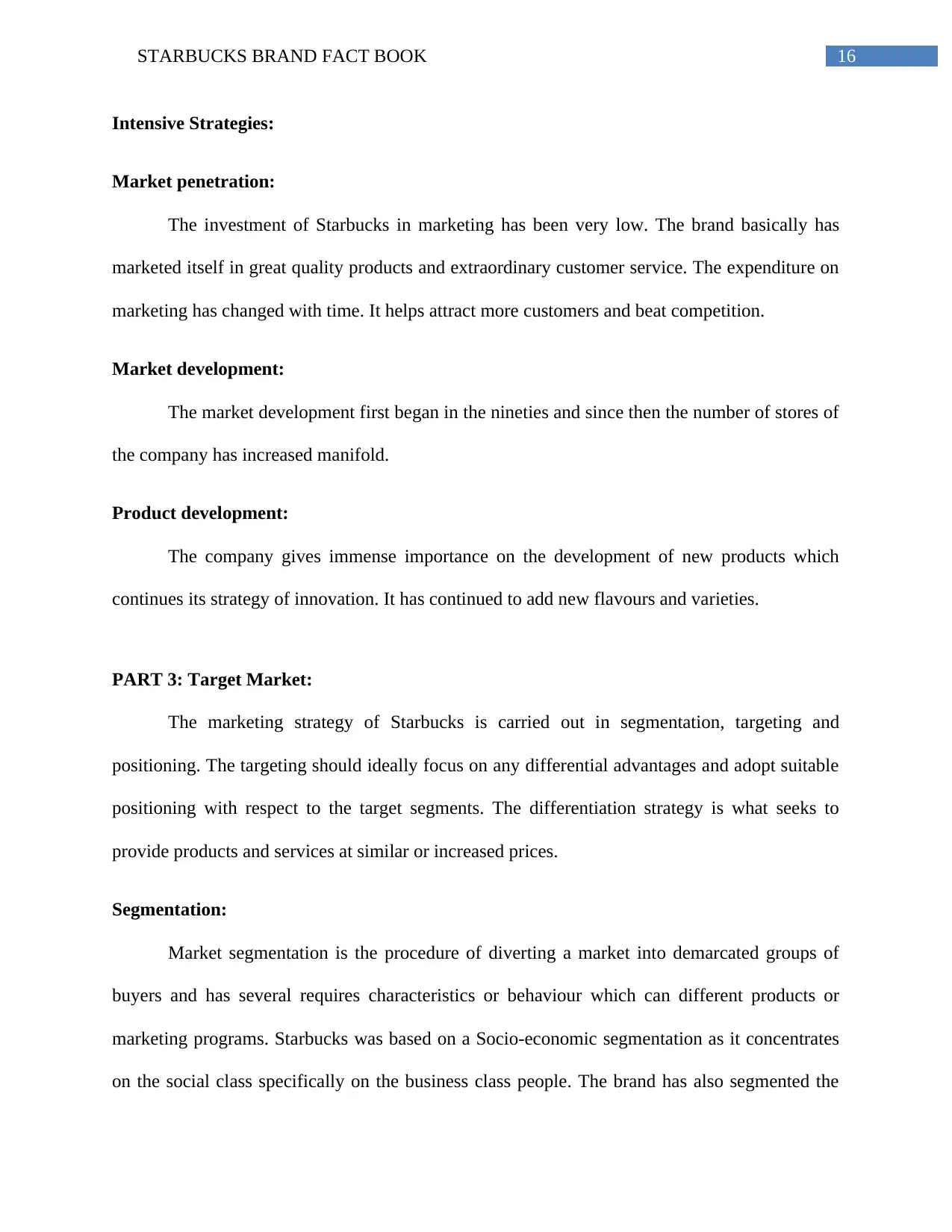
16STARBUCKS BRAND FACT BOOK
Intensive Strategies:
Market penetration:
The investment of Starbucks in marketing has been very low. The brand basically has
marketed itself in great quality products and extraordinary customer service. The expenditure on
marketing has changed with time. It helps attract more customers and beat competition.
Market development:
The market development first began in the nineties and since then the number of stores of
the company has increased manifold.
Product development:
The company gives immense importance on the development of new products which
continues its strategy of innovation. It has continued to add new flavours and varieties.
PART 3: Target Market:
The marketing strategy of Starbucks is carried out in segmentation, targeting and
positioning. The targeting should ideally focus on any differential advantages and adopt suitable
positioning with respect to the target segments. The differentiation strategy is what seeks to
provide products and services at similar or increased prices.
Segmentation:
Market segmentation is the procedure of diverting a market into demarcated groups of
buyers and has several requires characteristics or behaviour which can different products or
marketing programs. Starbucks was based on a Socio-economic segmentation as it concentrates
on the social class specifically on the business class people. The brand has also segmented the
Intensive Strategies:
Market penetration:
The investment of Starbucks in marketing has been very low. The brand basically has
marketed itself in great quality products and extraordinary customer service. The expenditure on
marketing has changed with time. It helps attract more customers and beat competition.
Market development:
The market development first began in the nineties and since then the number of stores of
the company has increased manifold.
Product development:
The company gives immense importance on the development of new products which
continues its strategy of innovation. It has continued to add new flavours and varieties.
PART 3: Target Market:
The marketing strategy of Starbucks is carried out in segmentation, targeting and
positioning. The targeting should ideally focus on any differential advantages and adopt suitable
positioning with respect to the target segments. The differentiation strategy is what seeks to
provide products and services at similar or increased prices.
Segmentation:
Market segmentation is the procedure of diverting a market into demarcated groups of
buyers and has several requires characteristics or behaviour which can different products or
marketing programs. Starbucks was based on a Socio-economic segmentation as it concentrates
on the social class specifically on the business class people. The brand has also segmented the
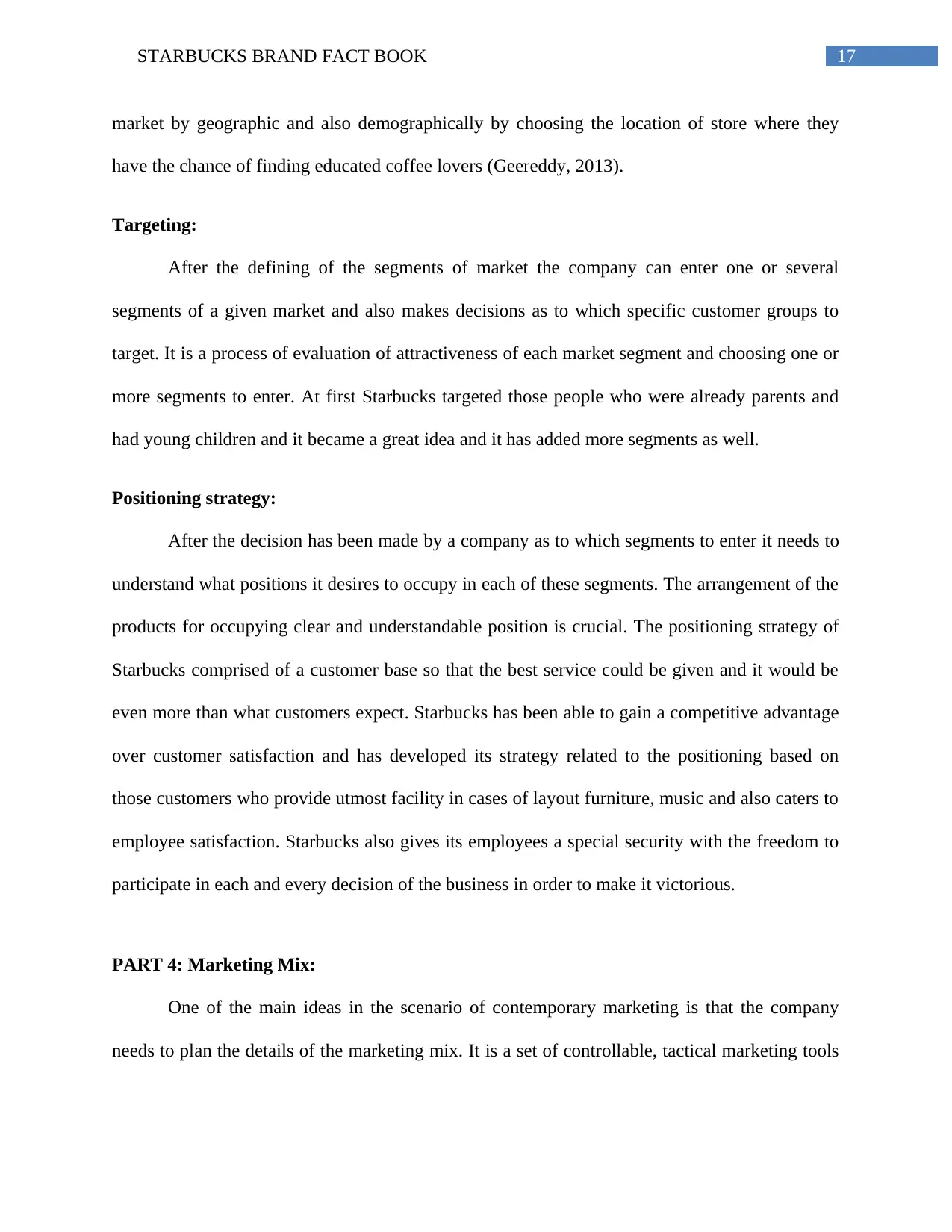
17STARBUCKS BRAND FACT BOOK
market by geographic and also demographically by choosing the location of store where they
have the chance of finding educated coffee lovers (Geereddy, 2013).
Targeting:
After the defining of the segments of market the company can enter one or several
segments of a given market and also makes decisions as to which specific customer groups to
target. It is a process of evaluation of attractiveness of each market segment and choosing one or
more segments to enter. At first Starbucks targeted those people who were already parents and
had young children and it became a great idea and it has added more segments as well.
Positioning strategy:
After the decision has been made by a company as to which segments to enter it needs to
understand what positions it desires to occupy in each of these segments. The arrangement of the
products for occupying clear and understandable position is crucial. The positioning strategy of
Starbucks comprised of a customer base so that the best service could be given and it would be
even more than what customers expect. Starbucks has been able to gain a competitive advantage
over customer satisfaction and has developed its strategy related to the positioning based on
those customers who provide utmost facility in cases of layout furniture, music and also caters to
employee satisfaction. Starbucks also gives its employees a special security with the freedom to
participate in each and every decision of the business in order to make it victorious.
PART 4: Marketing Mix:
One of the main ideas in the scenario of contemporary marketing is that the company
needs to plan the details of the marketing mix. It is a set of controllable, tactical marketing tools
market by geographic and also demographically by choosing the location of store where they
have the chance of finding educated coffee lovers (Geereddy, 2013).
Targeting:
After the defining of the segments of market the company can enter one or several
segments of a given market and also makes decisions as to which specific customer groups to
target. It is a process of evaluation of attractiveness of each market segment and choosing one or
more segments to enter. At first Starbucks targeted those people who were already parents and
had young children and it became a great idea and it has added more segments as well.
Positioning strategy:
After the decision has been made by a company as to which segments to enter it needs to
understand what positions it desires to occupy in each of these segments. The arrangement of the
products for occupying clear and understandable position is crucial. The positioning strategy of
Starbucks comprised of a customer base so that the best service could be given and it would be
even more than what customers expect. Starbucks has been able to gain a competitive advantage
over customer satisfaction and has developed its strategy related to the positioning based on
those customers who provide utmost facility in cases of layout furniture, music and also caters to
employee satisfaction. Starbucks also gives its employees a special security with the freedom to
participate in each and every decision of the business in order to make it victorious.
PART 4: Marketing Mix:
One of the main ideas in the scenario of contemporary marketing is that the company
needs to plan the details of the marketing mix. It is a set of controllable, tactical marketing tools
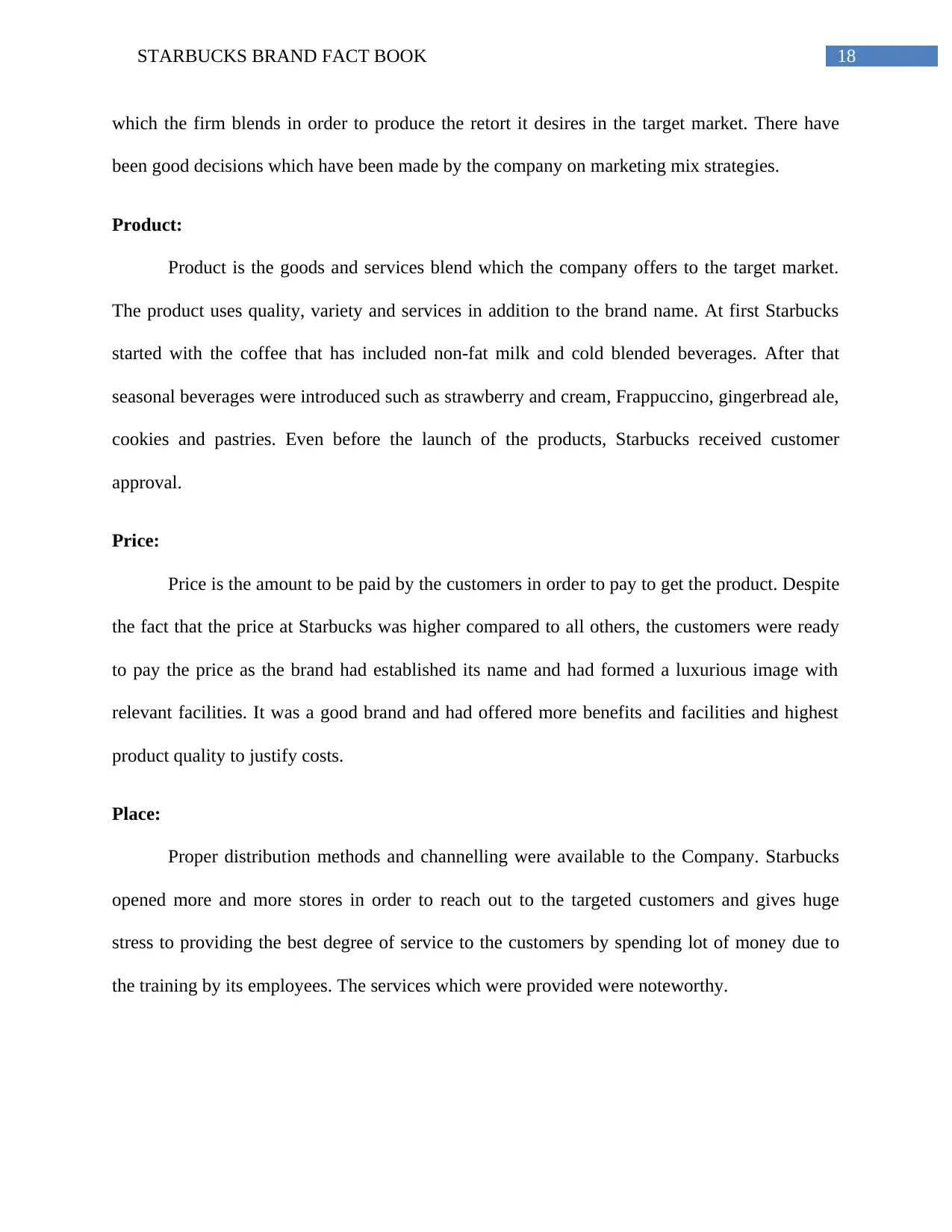
18STARBUCKS BRAND FACT BOOK
which the firm blends in order to produce the retort it desires in the target market. There have
been good decisions which have been made by the company on marketing mix strategies.
Product:
Product is the goods and services blend which the company offers to the target market.
The product uses quality, variety and services in addition to the brand name. At first Starbucks
started with the coffee that has included non-fat milk and cold blended beverages. After that
seasonal beverages were introduced such as strawberry and cream, Frappuccino, gingerbread ale,
cookies and pastries. Even before the launch of the products, Starbucks received customer
approval.
Price:
Price is the amount to be paid by the customers in order to pay to get the product. Despite
the fact that the price at Starbucks was higher compared to all others, the customers were ready
to pay the price as the brand had established its name and had formed a luxurious image with
relevant facilities. It was a good brand and had offered more benefits and facilities and highest
product quality to justify costs.
Place:
Proper distribution methods and channelling were available to the Company. Starbucks
opened more and more stores in order to reach out to the targeted customers and gives huge
stress to providing the best degree of service to the customers by spending lot of money due to
the training by its employees. The services which were provided were noteworthy.
which the firm blends in order to produce the retort it desires in the target market. There have
been good decisions which have been made by the company on marketing mix strategies.
Product:
Product is the goods and services blend which the company offers to the target market.
The product uses quality, variety and services in addition to the brand name. At first Starbucks
started with the coffee that has included non-fat milk and cold blended beverages. After that
seasonal beverages were introduced such as strawberry and cream, Frappuccino, gingerbread ale,
cookies and pastries. Even before the launch of the products, Starbucks received customer
approval.
Price:
Price is the amount to be paid by the customers in order to pay to get the product. Despite
the fact that the price at Starbucks was higher compared to all others, the customers were ready
to pay the price as the brand had established its name and had formed a luxurious image with
relevant facilities. It was a good brand and had offered more benefits and facilities and highest
product quality to justify costs.
Place:
Proper distribution methods and channelling were available to the Company. Starbucks
opened more and more stores in order to reach out to the targeted customers and gives huge
stress to providing the best degree of service to the customers by spending lot of money due to
the training by its employees. The services which were provided were noteworthy.
Paraphrase This Document
Need a fresh take? Get an instant paraphrase of this document with our AI Paraphraser

19STARBUCKS BRAND FACT BOOK
Promotion:
At first the advertising tool for promotion was not utilised by Starbucks but it was the
public relations and personal selling tool that assisted the company to achieve the target. Several
sales promotions were planned all round the country and also in other nations as it hoped that
more customers would purchase at times of financial hardships in which the people are less
likely to purchase. Different types of promotional strategies are utilised by the company. The
coffee house uses different deals in each area to represent the topographical variations in the way
in which the customers take their coffee.
The coffee house uses different deals in different countries keeping in mind the special
coffee habits of the customers in different places. With proper awareness of the coffee habits of
each of the customers and the specially chosen sales promotion, the Starbucks company shows
its concerns that are customer centric and company oriented. It simply knows its customers. The
relationship is also reflected in personal selling. The company staff are also suitably trained in
giving advice and product information. The company knows the way in which an intimate
relationship can be built by making all the customers extremely loyal.
Conclusion:
One of the leading companies across the globe, uses a very simple strategy. It believes in
the establishment of connection between the brand and its customers. The employees are treated
with dignity and respect and the company makes way for the production of good products and
services. Starbucks needs to keep the life cycle of the products in mind. The company needs time
to relocate to the market and coordinate the strategies. The success of Starbucks has been
achieved through outstanding service to the customers which is provided at each of the stores.
Promotion:
At first the advertising tool for promotion was not utilised by Starbucks but it was the
public relations and personal selling tool that assisted the company to achieve the target. Several
sales promotions were planned all round the country and also in other nations as it hoped that
more customers would purchase at times of financial hardships in which the people are less
likely to purchase. Different types of promotional strategies are utilised by the company. The
coffee house uses different deals in each area to represent the topographical variations in the way
in which the customers take their coffee.
The coffee house uses different deals in different countries keeping in mind the special
coffee habits of the customers in different places. With proper awareness of the coffee habits of
each of the customers and the specially chosen sales promotion, the Starbucks company shows
its concerns that are customer centric and company oriented. It simply knows its customers. The
relationship is also reflected in personal selling. The company staff are also suitably trained in
giving advice and product information. The company knows the way in which an intimate
relationship can be built by making all the customers extremely loyal.
Conclusion:
One of the leading companies across the globe, uses a very simple strategy. It believes in
the establishment of connection between the brand and its customers. The employees are treated
with dignity and respect and the company makes way for the production of good products and
services. Starbucks needs to keep the life cycle of the products in mind. The company needs time
to relocate to the market and coordinate the strategies. The success of Starbucks has been
achieved through outstanding service to the customers which is provided at each of the stores.
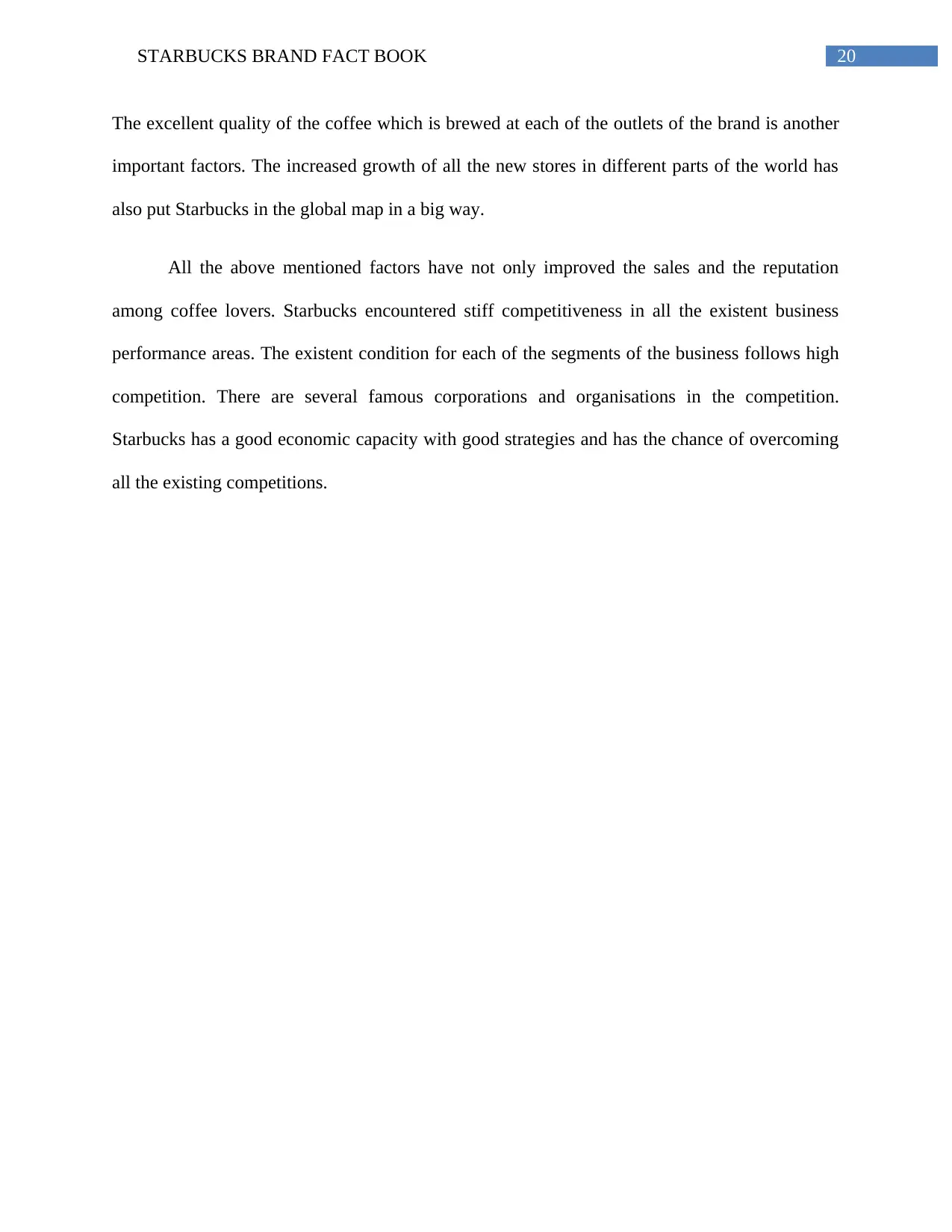
20STARBUCKS BRAND FACT BOOK
The excellent quality of the coffee which is brewed at each of the outlets of the brand is another
important factors. The increased growth of all the new stores in different parts of the world has
also put Starbucks in the global map in a big way.
All the above mentioned factors have not only improved the sales and the reputation
among coffee lovers. Starbucks encountered stiff competitiveness in all the existent business
performance areas. The existent condition for each of the segments of the business follows high
competition. There are several famous corporations and organisations in the competition.
Starbucks has a good economic capacity with good strategies and has the chance of overcoming
all the existing competitions.
The excellent quality of the coffee which is brewed at each of the outlets of the brand is another
important factors. The increased growth of all the new stores in different parts of the world has
also put Starbucks in the global map in a big way.
All the above mentioned factors have not only improved the sales and the reputation
among coffee lovers. Starbucks encountered stiff competitiveness in all the existent business
performance areas. The existent condition for each of the segments of the business follows high
competition. There are several famous corporations and organisations in the competition.
Starbucks has a good economic capacity with good strategies and has the chance of overcoming
all the existing competitions.
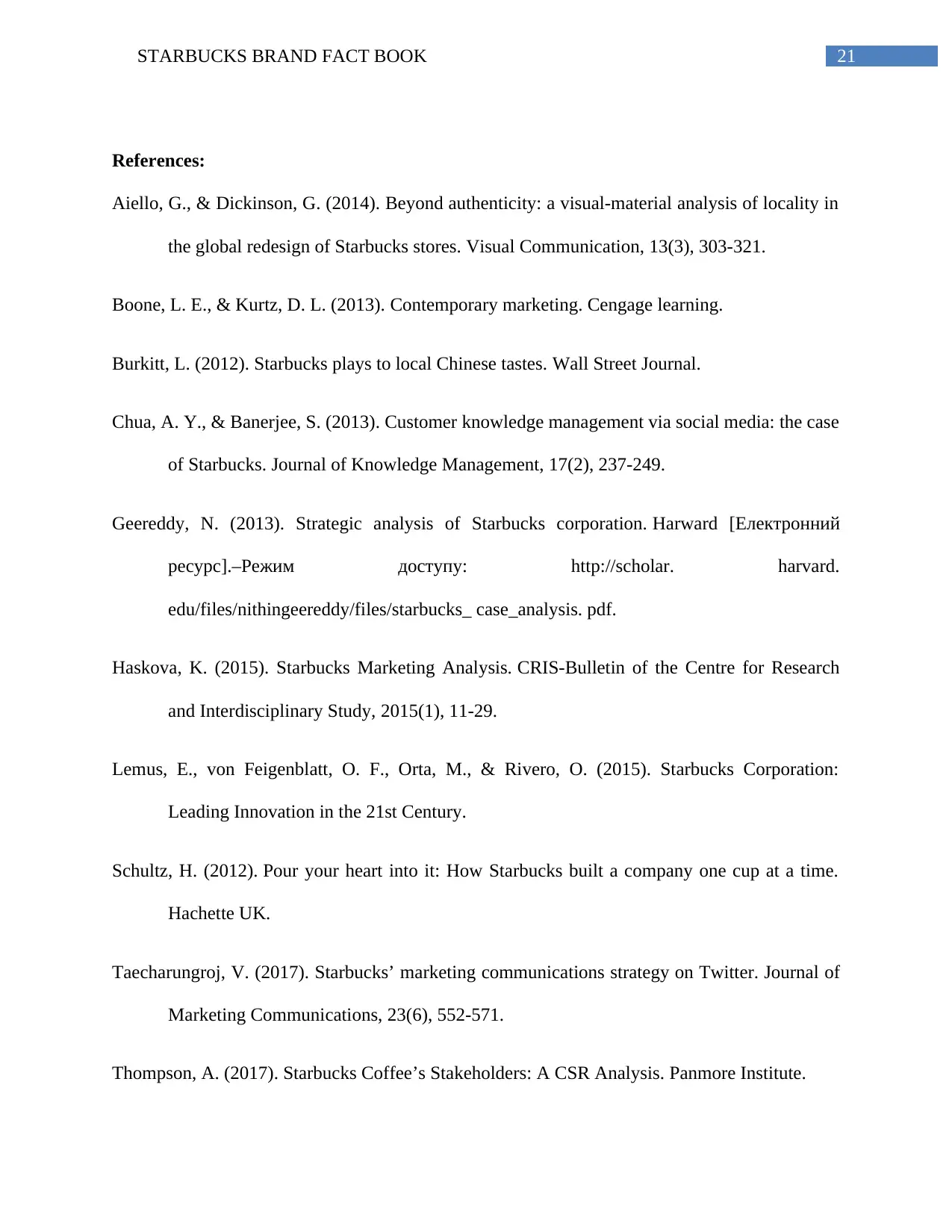
21STARBUCKS BRAND FACT BOOK
References:
Aiello, G., & Dickinson, G. (2014). Beyond authenticity: a visual-material analysis of locality in
the global redesign of Starbucks stores. Visual Communication, 13(3), 303-321.
Boone, L. E., & Kurtz, D. L. (2013). Contemporary marketing. Cengage learning.
Burkitt, L. (2012). Starbucks plays to local Chinese tastes. Wall Street Journal.
Chua, A. Y., & Banerjee, S. (2013). Customer knowledge management via social media: the case
of Starbucks. Journal of Knowledge Management, 17(2), 237-249.
Geereddy, N. (2013). Strategic analysis of Starbucks corporation. Harward [Електронний
ресурс].–Режим доступу: http://scholar. harvard.
edu/files/nithingeereddy/files/starbucks_ case_analysis. pdf.
Haskova, K. (2015). Starbucks Marketing Analysis. CRIS-Bulletin of the Centre for Research
and Interdisciplinary Study, 2015(1), 11-29.
Lemus, E., von Feigenblatt, O. F., Orta, M., & Rivero, O. (2015). Starbucks Corporation:
Leading Innovation in the 21st Century.
Schultz, H. (2012). Pour your heart into it: How Starbucks built a company one cup at a time.
Hachette UK.
Taecharungroj, V. (2017). Starbucks’ marketing communications strategy on Twitter. Journal of
Marketing Communications, 23(6), 552-571.
Thompson, A. (2017). Starbucks Coffee’s Stakeholders: A CSR Analysis. Panmore Institute.
References:
Aiello, G., & Dickinson, G. (2014). Beyond authenticity: a visual-material analysis of locality in
the global redesign of Starbucks stores. Visual Communication, 13(3), 303-321.
Boone, L. E., & Kurtz, D. L. (2013). Contemporary marketing. Cengage learning.
Burkitt, L. (2012). Starbucks plays to local Chinese tastes. Wall Street Journal.
Chua, A. Y., & Banerjee, S. (2013). Customer knowledge management via social media: the case
of Starbucks. Journal of Knowledge Management, 17(2), 237-249.
Geereddy, N. (2013). Strategic analysis of Starbucks corporation. Harward [Електронний
ресурс].–Режим доступу: http://scholar. harvard.
edu/files/nithingeereddy/files/starbucks_ case_analysis. pdf.
Haskova, K. (2015). Starbucks Marketing Analysis. CRIS-Bulletin of the Centre for Research
and Interdisciplinary Study, 2015(1), 11-29.
Lemus, E., von Feigenblatt, O. F., Orta, M., & Rivero, O. (2015). Starbucks Corporation:
Leading Innovation in the 21st Century.
Schultz, H. (2012). Pour your heart into it: How Starbucks built a company one cup at a time.
Hachette UK.
Taecharungroj, V. (2017). Starbucks’ marketing communications strategy on Twitter. Journal of
Marketing Communications, 23(6), 552-571.
Thompson, A. (2017). Starbucks Coffee’s Stakeholders: A CSR Analysis. Panmore Institute.
Secure Best Marks with AI Grader
Need help grading? Try our AI Grader for instant feedback on your assignments.
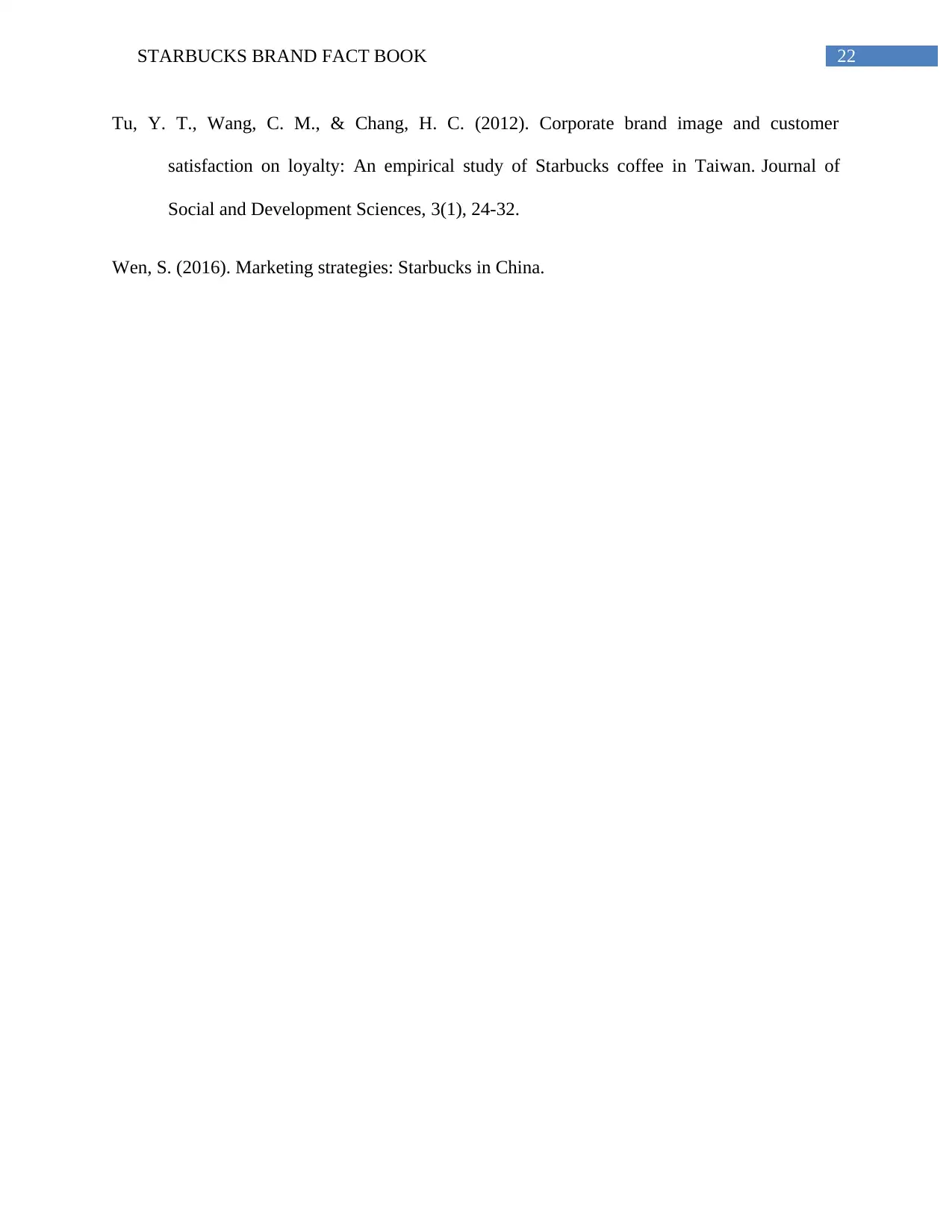
22STARBUCKS BRAND FACT BOOK
Tu, Y. T., Wang, C. M., & Chang, H. C. (2012). Corporate brand image and customer
satisfaction on loyalty: An empirical study of Starbucks coffee in Taiwan. Journal of
Social and Development Sciences, 3(1), 24-32.
Wen, S. (2016). Marketing strategies: Starbucks in China.
Tu, Y. T., Wang, C. M., & Chang, H. C. (2012). Corporate brand image and customer
satisfaction on loyalty: An empirical study of Starbucks coffee in Taiwan. Journal of
Social and Development Sciences, 3(1), 24-32.
Wen, S. (2016). Marketing strategies: Starbucks in China.
1 out of 23
Related Documents
Your All-in-One AI-Powered Toolkit for Academic Success.
+13062052269
info@desklib.com
Available 24*7 on WhatsApp / Email
![[object Object]](/_next/static/media/star-bottom.7253800d.svg)
Unlock your academic potential
© 2024 | Zucol Services PVT LTD | All rights reserved.




